Brimstone is a potent and precision-guided anti-armour missile that arms RAF Typhoons and Protectors
The RAF describe Brimstone as;
Brimstone is an advanced, rocket-propelled, radar-guided weapon and can seek and destroy armoured targets at long range. For indirect mode, weapons are launched when the targets and their position are not visible to the attacking aircraft, whereas, in direct mode, the pilot uses an on board sighting system to select the target. The target can lie off the aircraft’s track obviating need for the pilot to manoeuvre to release weapons.
Brimstone is currently integrated into Typhoon, with the Protector RPAS also planned.
F-35B integration was dropped some time ago in favour of SPEAR Capability 3 and the British Army has selected the Joint Air to Ground Missile (JAGM) for use on AH-64E Attack Helicopters.
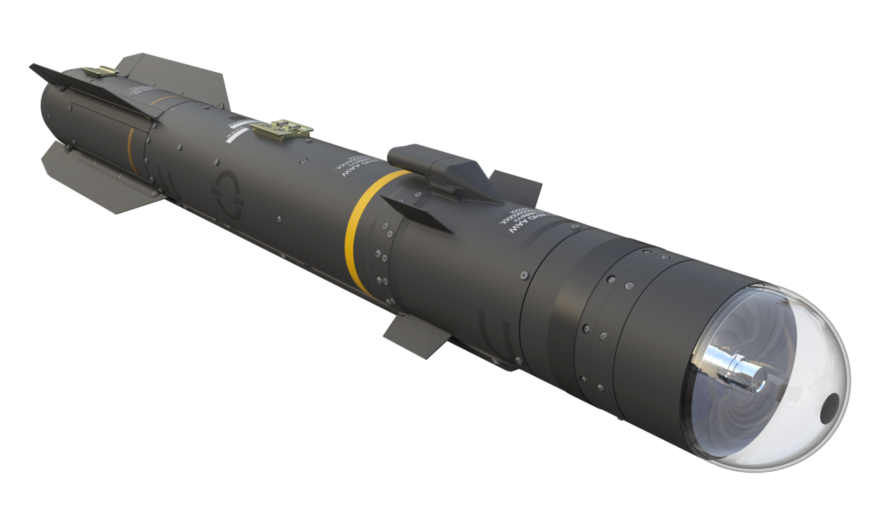
Brimstone History
VJ.291
Replacing the RAF’s SNEB rockets, the 680 kg BL755 Cluster Bomb entered service in 1973. Driving the adoption of BL755 were concerns about aircrew survivability in the face of Soviet air defences, especially the 4-barrelled ZSU-23-4 Shilka
The effectiveness of modern air defence systems in the field is such that the use of dive-bombing or rocket attacks is likely to involve an unacceptable casualty rate
This would be a recurring theme
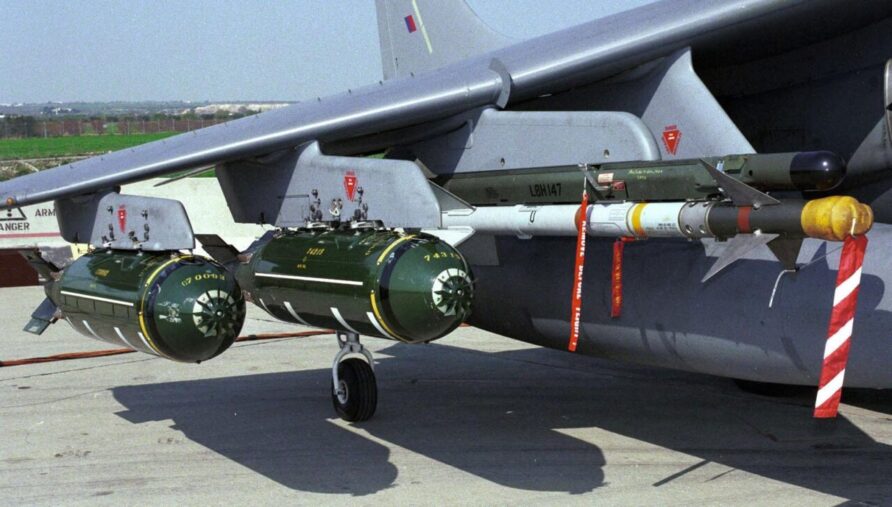
Hunting Engineering BL-755 Anti Armour Cluster Bomb — Video 1
Hunting Engineering BL-755 Anti Armour Cluster Bomb — Video 2
Air Staff Target 1227 came about as a replacement for BL755, intended to provide more precision and greater safety factors for friendly troops in close contact. Two designs were initially proposed, a modified SRAAM (that would go on to become ASRAAM) and a missile from BAE called Sabre.
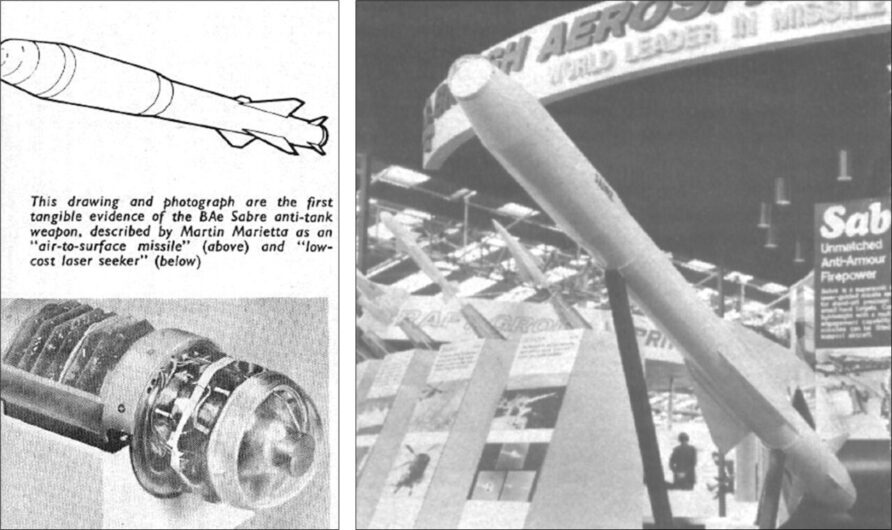
In parallel, a steerable cluster bomb project called VJ.291 was also mooted, and intended to replace the Hunting Engineering BL-755 anti-armour cluster bomb.
Instead of developing VJ291 or pursuing AST.1227, the MoD decided to improve the BL755 cluster bomb rather than purchase the US Maverick missile, stating that the more demanding stand-off requirement would eventually be developed through the Staff Requirement (Air) 1238, endorsed in 1981.
1981 marks the starting point for Brimstone.
SRA(A) 1238 Round 1
Initial scoping studies for SRA 1238 commenced in 1982 and by the late eighties, the MoD completed a broad market survey with several systems emerging as likely candidates with some in full compliance with the requirement, and others only partial.
The two fully compliant systems were;
- British Aerospace Advanced Air-Launched Anti-Armour Weapon (AALAAW)
- Hunting Engineering unmanned system
The partially compliant systems were;
- ML/Rheinmetall Damocles
- British Aerospace/Hughes Maverick
- Marconi/Rockwell Brimstone
- Hunting/Honeywell SWAARM
The Damocles ant-armour cluster bomb was developed by ML Aviation and Rheinmetall. ML provided the lightweight submunition dispenser body, and Rheinmetall, the submunition payload, based on its ZEPL weapon developed for 155 mm and 203 mm artillery weapons.
Each Damocles could carry submunitions (bomblets), with these comprising a cylindrical Explosively Formed Projectile, a retarding parachute, and an infrared guidance sensor.
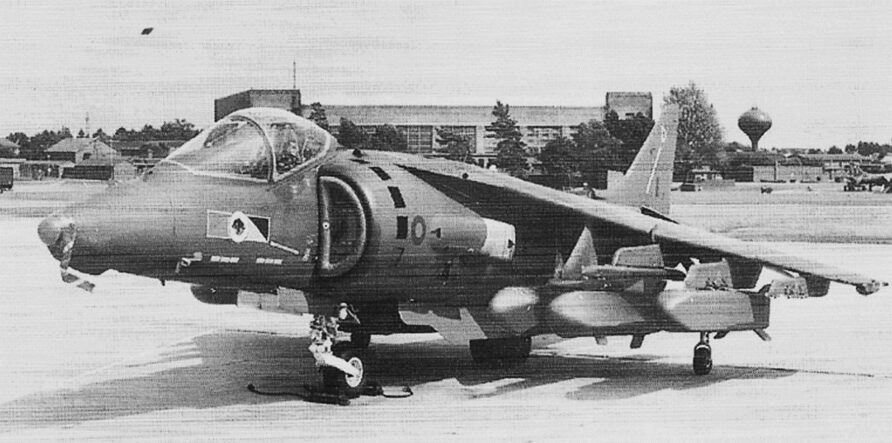
Once the body was released, it glided to a release point, upon which the individual submunitions were also released. The parachute deploys and the projectile spun in a so-called ‘nutation mode’ that allows the sensor to seek targets on its descent, before firing the EFP at the top of any vehicles in the zone of view.

Brimstone was still at a relatively early stage of development.
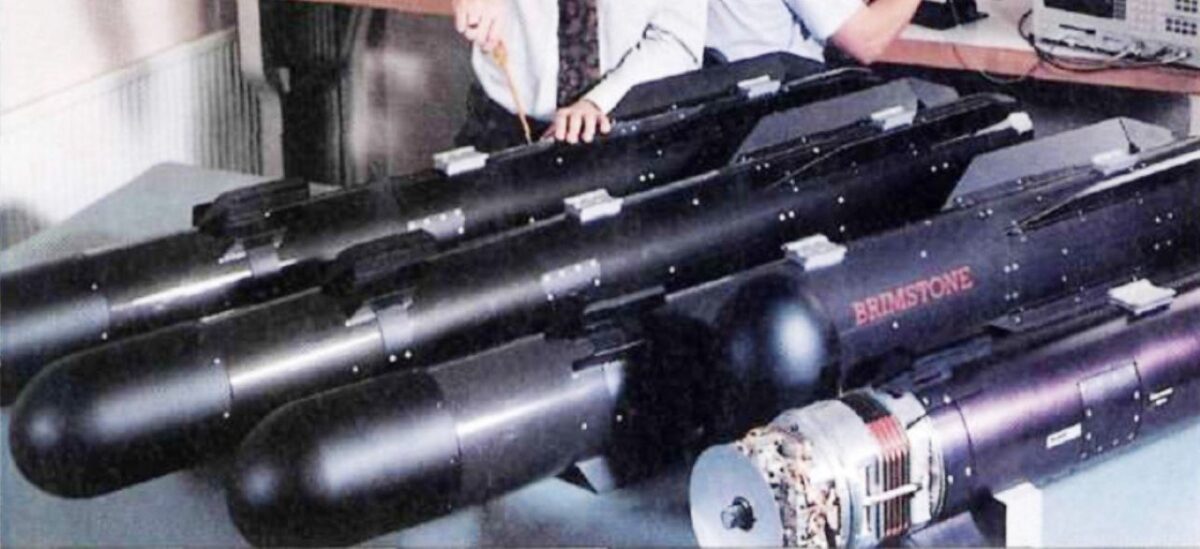
Hunting Engineering developed Smart Weapon Anti-Armour (SWAARM)
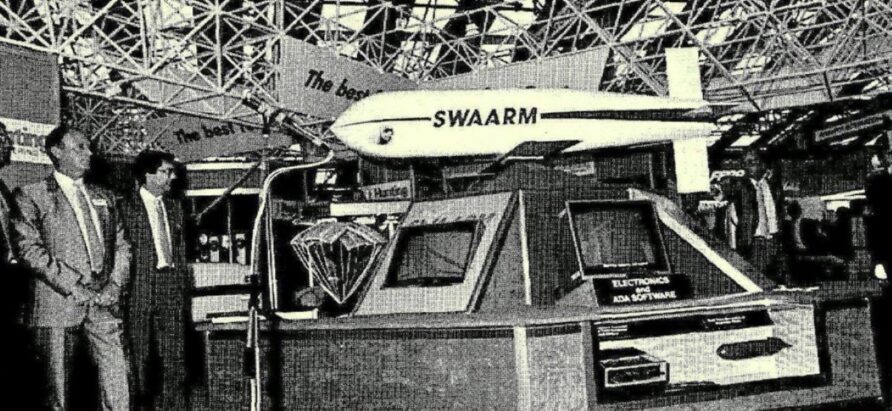
The MoD then became involved with the Modular Stand-Off Weapon (MSOW) programme
FOFA and MSOW
The 1986 US Defense Authorization Bill included an amendment, often referred to as the Nunn Amendment (although there were multiple authors), which allocated $200m per year for five years for collaborative weapons development programmes. It also included $50m for side-by-side US/European weapon testing.
This funding, alongside various working groups and committees, set the scene for a number of US/European collaborative programmes.
In parallel, NATO was grappling with the problem of numerically superior and, in numerous instances, technically superior, Warsaw Pact forces. To maintain deterrence, conventional NATO forces would need to be able to avoid being overwhelmed so quickly that they would have to escalate early to battlefield nuclear weapons.
The Follow On Forces Attack (FOFA) concept was published in July 1986, designed to even the odds by destroying follow on Warsaw Pact forces before they could join the initial attack force. FOFA was a concept rather than a development programme, and it envisaged my interconnecting and overlapping ground and air-launched weapons. In the UK’s case, this meant MLRS, ASTOR and Phoenix RPV.
As it developed, five main packages or categories were defined;
- 5 km to 30 km from FLOT against moving targets, e.g. tank regiments
- 30 km to 80 km from FLOT against moving targets, e.g. follow-on divisions of first-echelon armies
- 80 km to 150 km from FLOT against choke points and high-value static targets such as command posts
- 150 km to 400 km from FLOT against bridges and other static targets
- 600 km to 850 km against rail facilities
FLOT = Forward Line of Own Troops
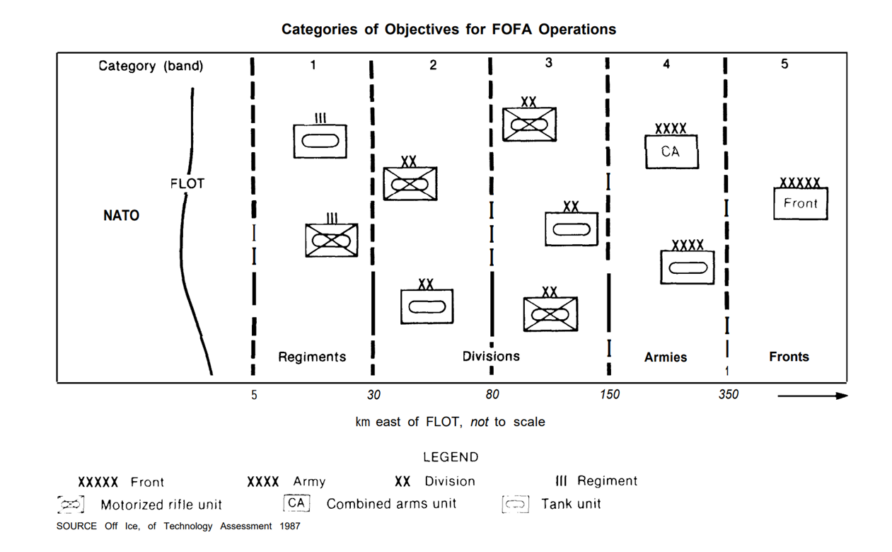

The Modular Stand-Off Weapon (MSOW) was proposed for Category 2 and 4
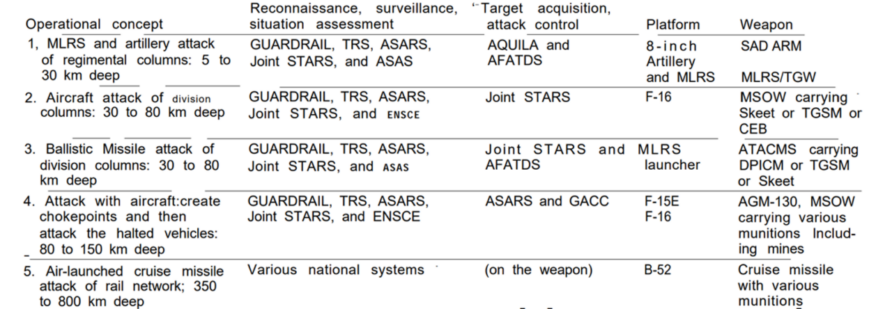
Later in 1986, representatives from France, Canada, Germany, Italy, Spain, the UK, and USA signed a letter of intent to develop MSOW, and it was hoped this letter of intent would lead to a memorandum of understanding, and then a more formal development programme.
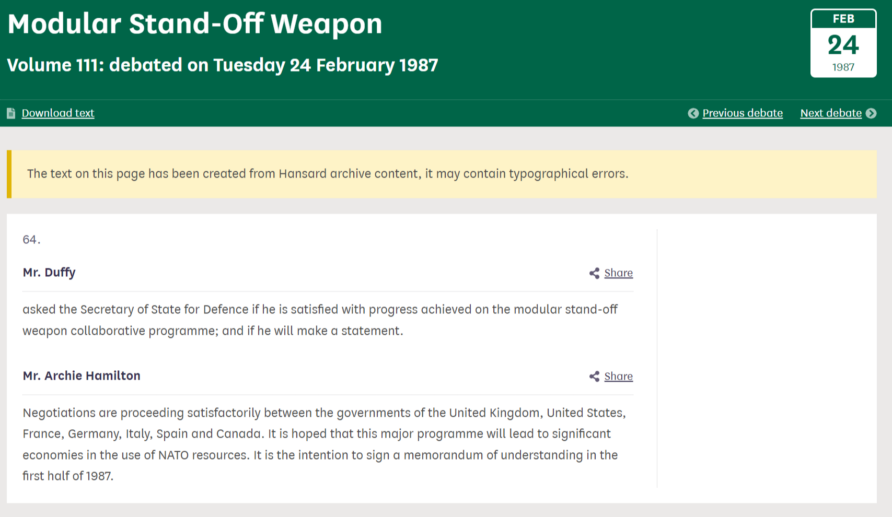
In September 1987, a Request for Proposal was released for the Project Definition phase with Alliance Defence Corporation (headed by Rockwell) beating General Dynamics.
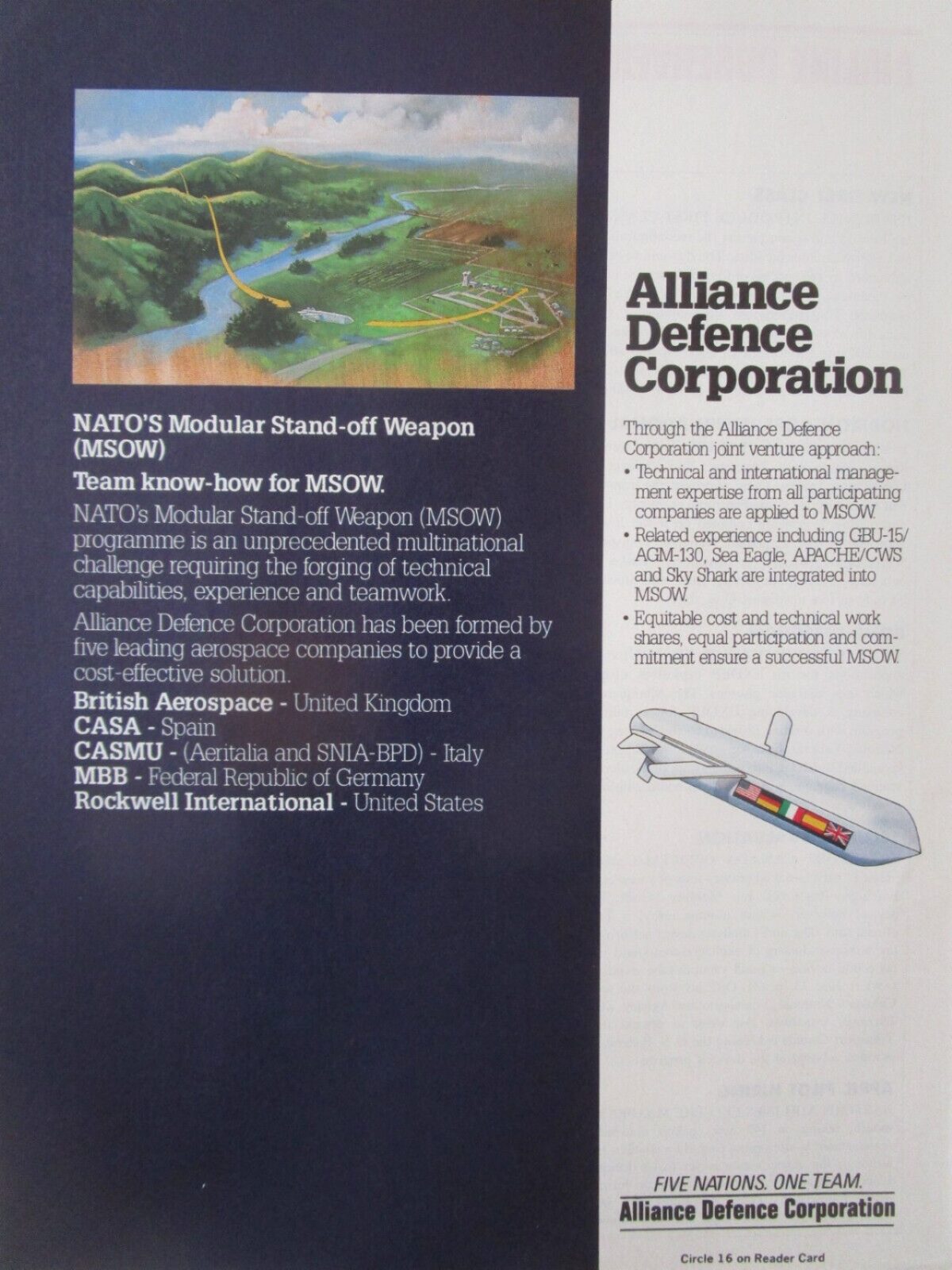
Following this, In 1988, the MoD selected Brimstone and SWAARM for further risk reduction development, noting that a partially compliant system would be both faster into service and cheaper, serving as an interim capability before the multinational Modular Stand-Off Weapon was delivered.
MSOW was another familiar late eighties/early nineties multinational NATO programme that was ambitious and entirely laudable but never progressed. France and Canada exited the programme early, and then in 1989, the USAF also withdrew, reportedly over differences in the concept of operations with the RAF.
And that was the end of MSOW, it never progressed beyond concepts.
The Options for Change Defence White Paper in 1990 ceased funding for SRA 1238, Alan Clarke, Minister for Defence Procurement, was quoted in the trade press;
The MoD may wish to consider designs to less stringent criteria, we have decided not to proceed with the advanced airborne, anti-armour weapon to SR(A) 1238 at this stage
Experience from the 1991 Gulf War demonstrated a clear need for a fast jet launched, anti-armour weapon and the project was resurrected. Post-conflict submunitions clearance proved to major issue, hastening the move away from simple cluster bombs.
SRA 1238 — Again
In 1992, the Staff Requirement (Air) 1238 was re-issued, the weapon would be known as the Advanced Anti-Armour Weapon (AAAW)
SR(A) 1238 was still very demanding, requiring a completely autonomous weapon to provide an all-weather, day/night system that could defeat all known armour and with a generous margin for future growth.
SR(A) 1238 was presented to the industry as a Cardinal Points Specification which mandated compliance with certain key user requirements and gave scope for new developments or off-the-shelf designs.
Because of the anti-aircraft weapon density in the likely operating environment, the launching aircraft was required to release the weapon from a safe stand-off distance and at either medium or low altitude whilst flying at supersonic speeds.
As a final requirement, logistics support and maintenance had to be simple.
Five submissions were received for the AAAW programme, two missiles, two submunitions dispensers, and one that was a hybrid of the two.
Typhoon
BAE proposed an anti-armour variant of the new ASRAAM anti-aircraft missile, extolling the virtue of commonality. The missile was called Typhoon and would also retain an anti-aircraft capability, a universal missile of sorts.
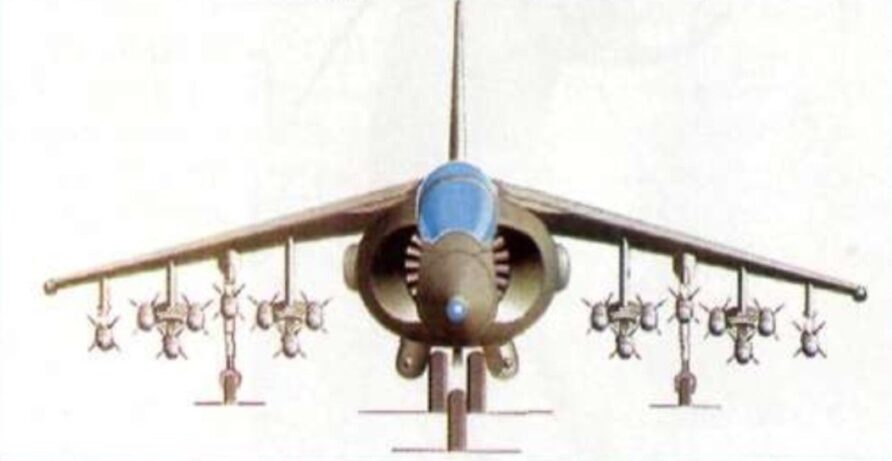
This missile was also proposed as an inner layer air defence missile for the Horizon Next-Generation Frigate programme, and would eventually become CAMM and Sea Ceptor.
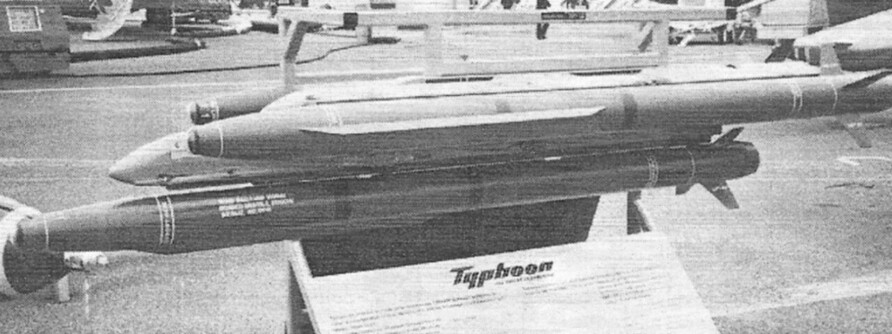
The image above shows three Typhoon missiles on a Sidewinder pylon at the 1995 Paris Air Show.
Typhoon used a tandem warhead from the then-in-development TRIGAT-LR anti-tank missile and retained the Hughes Imaging IR seeker from ASRAAM. It weighed 77 kg and was reported as having a range of approximately 10 km.
SWAARM
In 1991, Hunting Engineering reconfigured their dispenser body to use the Daimler-Benz Aerospace Mehrzweckwaffe 2 DWS-24 dispenser with up to 16 Sensor and Destroy Munitions (SADARM) that had been developed by Alliant Techsystems in the USA for the Multiple Launch Rocket System (MLRS).
SADARM used both a dual mode infra-red and active/passive millimetric radar sensor, but like Damocles, used an EFP warhead for top attacks against armoured vehicles.
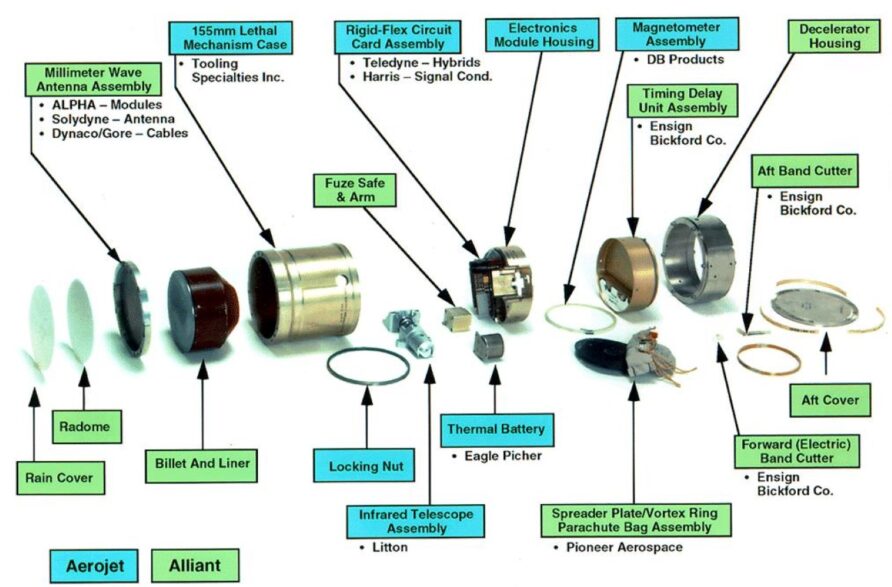
The 450 kg SWAARM 2 was renamed SWAARM 2000, using pop-out sub-wings to enable greater stand-off range than conventional free-fall cluster bombs.
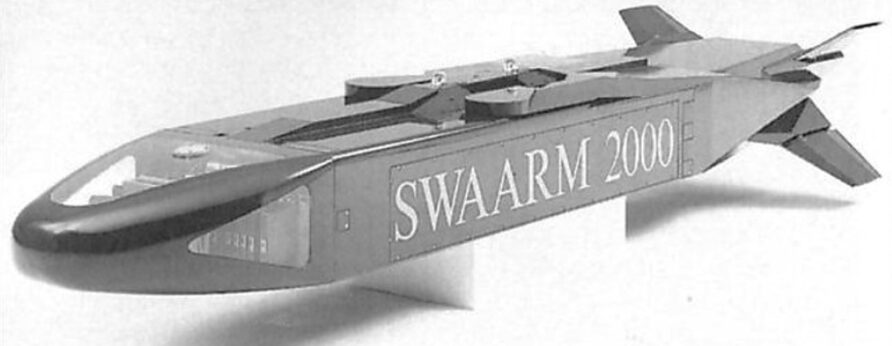
After a toss bombing release, the dispenser was guided to the target area using an inertial navigation unit and, when over the target area, ejected the submunitions in a helical search pattern. The MMW and Infra-Red sensor would scan for targets and when one was found, deploy a parachute to place the submunition at the optimum height above the target until detonation.
Griffin 38
Also with a submunition’s dispenser, Texas Instruments/Shorts proposed the Griffin 38, a system that would evolve into the Joint Stand-Off Weapon (JSOW)

Brimstone
GEC Marconi resubmitted their Brimstone missile, this time with Boeing (having purchased Rockwell in 1996). GEC-Marconi Radar and Defence Systems and Alenia Difesa merged in 1998.
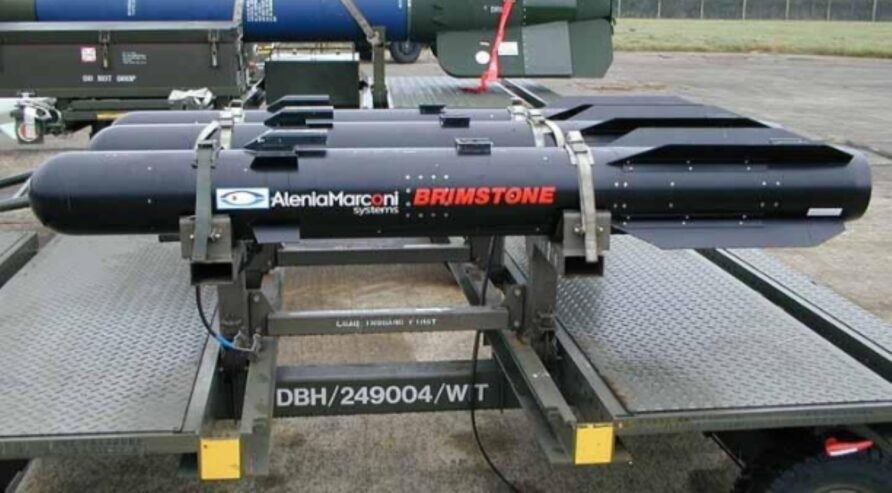
Although Brimstone was based on the 50 kg Boeing AGM-114F Hellfire chassis, it was the millimetric wavelength radar and advanced seeker that set Brimstone apart from other offerings.

The radar was responsible for acquisition and target recognition, and the guidance system, which could distinguish between, for example, the main battle tank and a truck, would actuate the fins to guide the missile to the target. The first stage of the tandem warhead nullified reactive armour, allowing the second stage warhead to penetrate the main armour behind.
TAAWS
Thomson-Thorn entered a modified version of the BL755 called the Advanced Anti Armour Weapons System (TAAWS) that used three terminally guided sub-munitions (TGSMs). In indirect-attack mode, the rocket motor burns for two seconds, in direct-attack mode, the motor is ejected immediately after release from the housing.
The TGSM themselves (shown in the image below) were ejected using a gas bag system.
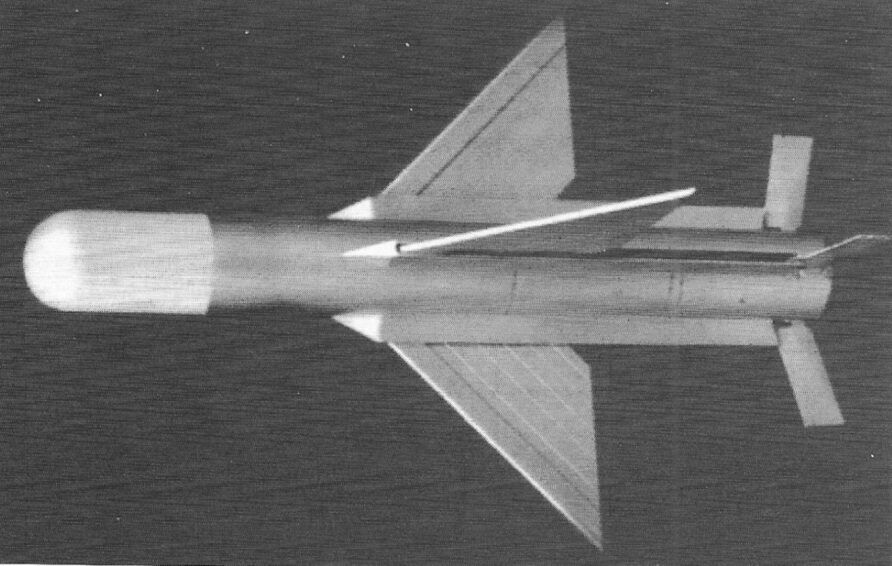
TAAWS built on the Smart Weapon Anti-Armour Thorn-Hunting Engineering (SWATHE) design as used for the Multiple Launch Rocket System (MLRS) 3 programme.
Brimstone Wins
After bid assessment in 1995, and nearly a decade after the initial SRA 1286 was issued to the industry, in 1996, the winner was the GEC-Marconi Radar and Defence Systems Ltd (GMRDS) Brimstone.
The submunitions dispensers were incremental improvements over traditional cluster bombs like the BL-755.
The RAF didn’t want an incremental improvement, though.
Brimstone was selected because of one simple thing, aircrew/aircraft survivability. The other options could destroy armoured vehicles to a greater or lesser degree, but none could do so at the aircraft ranges, altitudes and attitudes of Brimstone.
Initial RAF analysis from the early stages of SR(A) 1238 development concluded that Warsaw Pact forces would be considerably numerically superior, and in the time it took them to go from their start positions to NATO capitulation or nuclear release, NATO forces would be unable to train additional aircrew or take delivery of new aircraft. They would get one shot, and each aircraft and aircrew would have to make multiple sorties.
By the time of the contract award, the Warsaw Pact was long gone but experience in Iraq with Tornado aircraft being shot down by Iraqi air defences reinforced the message, the ability to deliver effect AND get home, was essential.
Brimstone, with its ability to stand-off and be fired at any altitude, coupled with its extremely advanced fire-and-forget target recognition and guidance system, won the day.
The contract value was £700m and the in-Service Date was initially predicted to be 2001.
The Design Authority was Alenia Marconi Systems, with Boeing as a major subcontractor. Flight Refuelling Ltd was the Design Authority for the three-round launcher structure (image below) with Air Log Ltd, responsible for manufacturing the missile Special to Type Container.
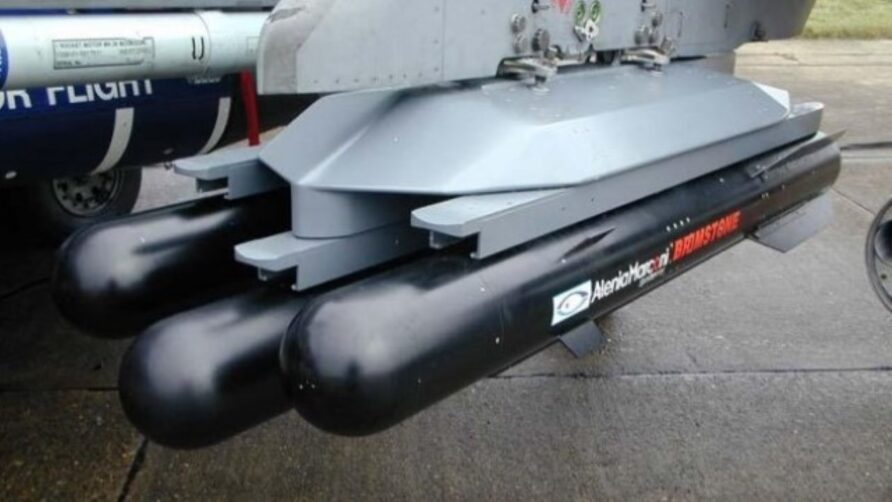
Brimstone was intended to operate from Tornado GR4, Harrier GR.9/9A, Typhoon and WAH-64D, and would be the first anti-tank guided missile to equip any NATO fast jet.
After the contract issue in November 1996, fit checks were carried out on Harrier and Tornado.
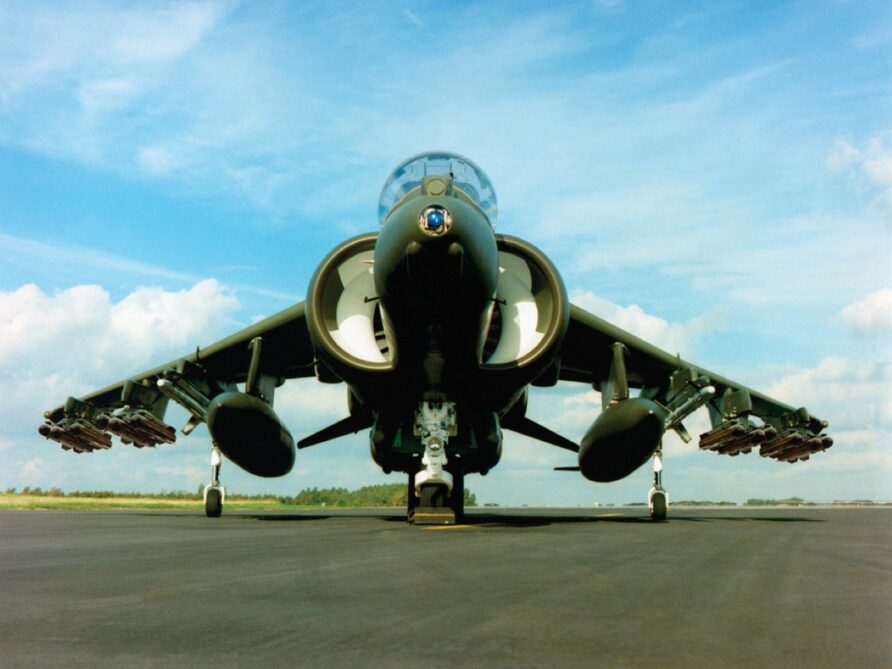
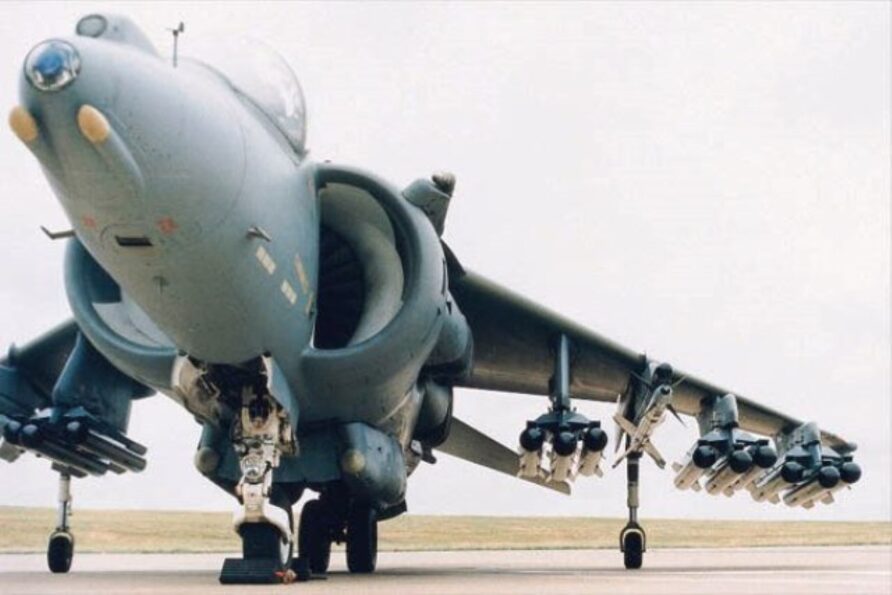
In 1998, GEC-Marconi Radar and Defence Systems Ltd. and Alenia Difesa from Italy merged to form Alenia Marconi Systems (AMS).
The joint US/UK Future Scout and Cavalry System (FSCS) and British Tactical Reconnaissance Armoured Combat Equipment Requirement (TRACER) development programme in the late nineties included the option for an overwatch variant (to replace CVR(T) Striker). The LANCER consortium included GEC Marconi, and naturally, they proposed Brimstone for the role, replacing the Swingfire missile.
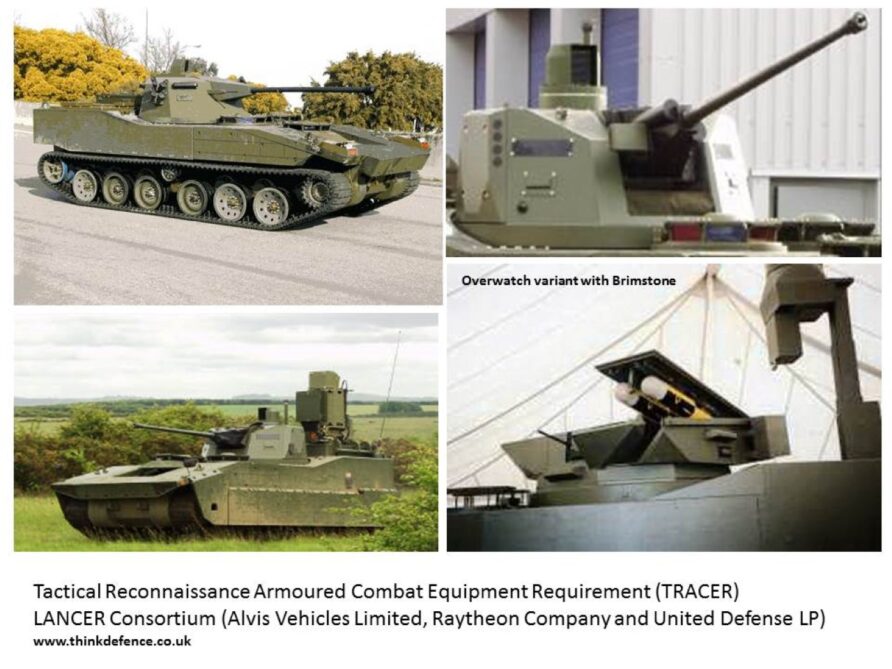
On Aug. 12, 1999, a Brimstone missile was successfully launched for the first time at the US Army’s Yuma Proving Ground, from a ground launcher mounted on a test platform. Several ground-based trials followed.
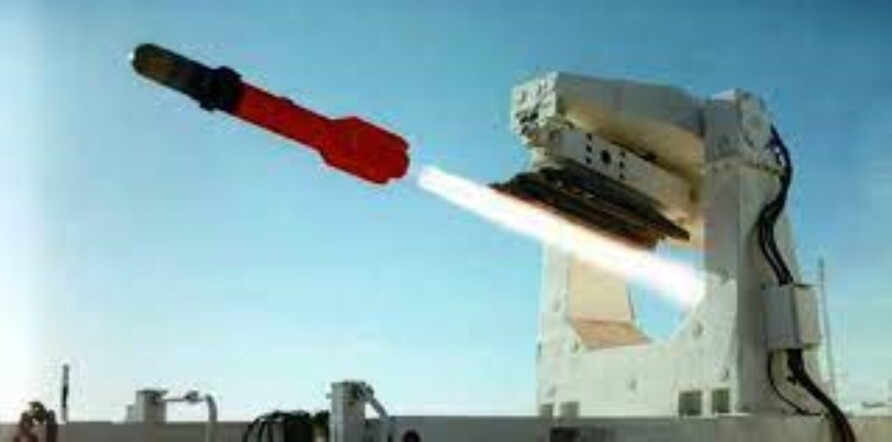
Also in early 1999, GEC sold the Marconi Electronic Systems (MES) division to British Aerospace (BAe), and on Nov. 30, 1999, MES and BAe formed BAE Systems, which then owned the 50% share in AMS.
Initial airborne carriage trials were conducted the same year using instrumented missiles.
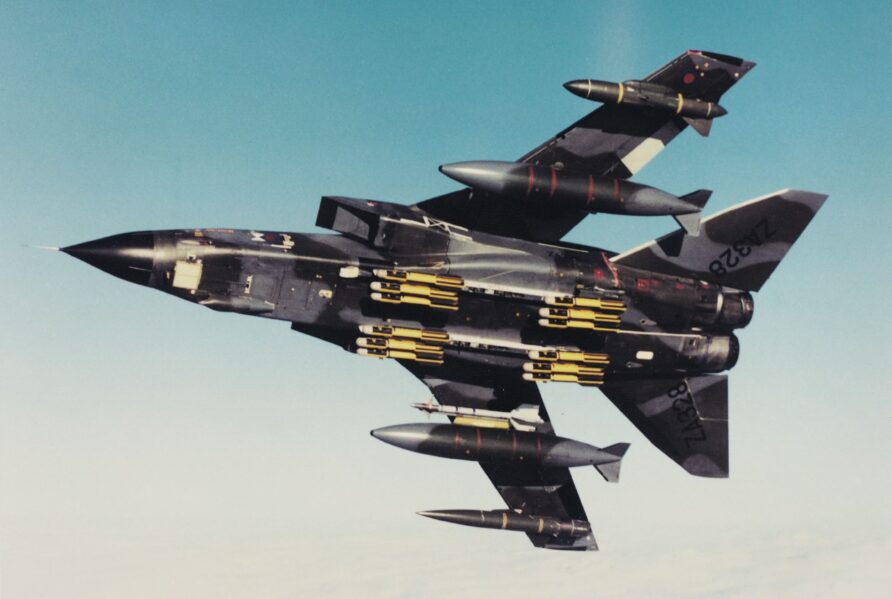
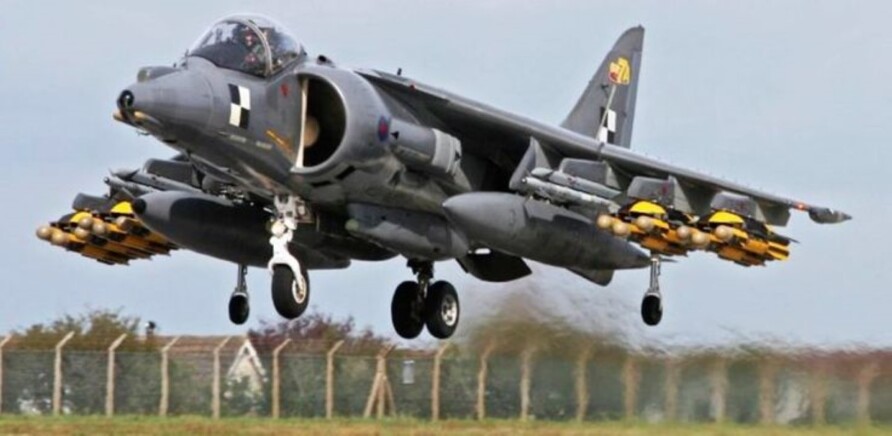
Air launches followed the year after in 2000, concluding in 2001
Further testing continued in the UK, including proving the MIL-STD 1760 interface used to transmit data between the missile and a launch aircraft.
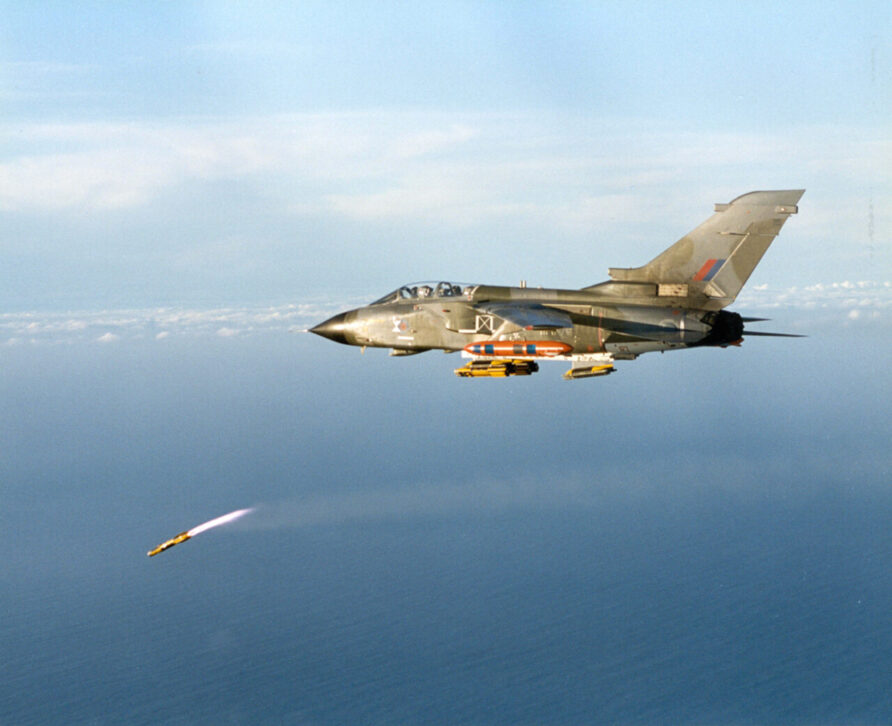
Also in 2000, Alenia Marconi Systems floated the idea of a laser-guided version of Brimstone it had been developing to the MoD, but no further action was taken, instead, an Urgent Operational Requirement (UOR) purchase of AGM-65G2 Maverick missiles was made for use by the RAF Harrier fleet as an interim anti-tank capability.
Operations in the Balkans had identified a clear need for an air-launched weapon that could be used in all weathers.
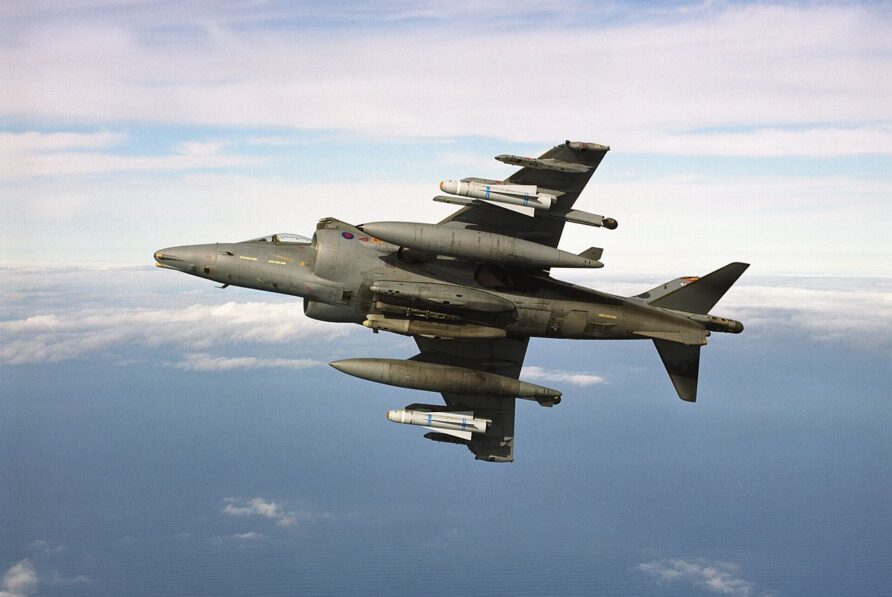
There was some discussion with the US about incorporating Brimstone guidance technology into the US Army Common Modular Missile (CMM) that was intended to replace Hellfire and TOW on ground and air platforms.
MBDA was formed in 2001 by the merger of AMS, Aérospatiale Matra Missiles and Matra BAe Dynamics
Guided tests were successfully conducted in late 2001 and in 2002.
A 2002 Parliamentary answer revealed;
The advanced air-launched anti-armour weapon project, BRIMSTONE, has approval to spend up to £849 million, but is currently forecast to spend some £809 million
In 2003, technical problems and launch aircraft availability delayed the in-service date;
The entry into service of the Brimstone, air-launched anti-armour weapon has been delayed because of technical factors that have emerged during the development and trials of the missile and its production. A revised date is currently under review.
These were resolved, and the production contract was finalised in October 2003 with the first production missiles delivered in 2004.
Entry into Service
Brimstone entered service with the RAF on the 31st of March 2005, 23 years after the original work on a replacement for the BL755 and the initial release of SRA 1282.
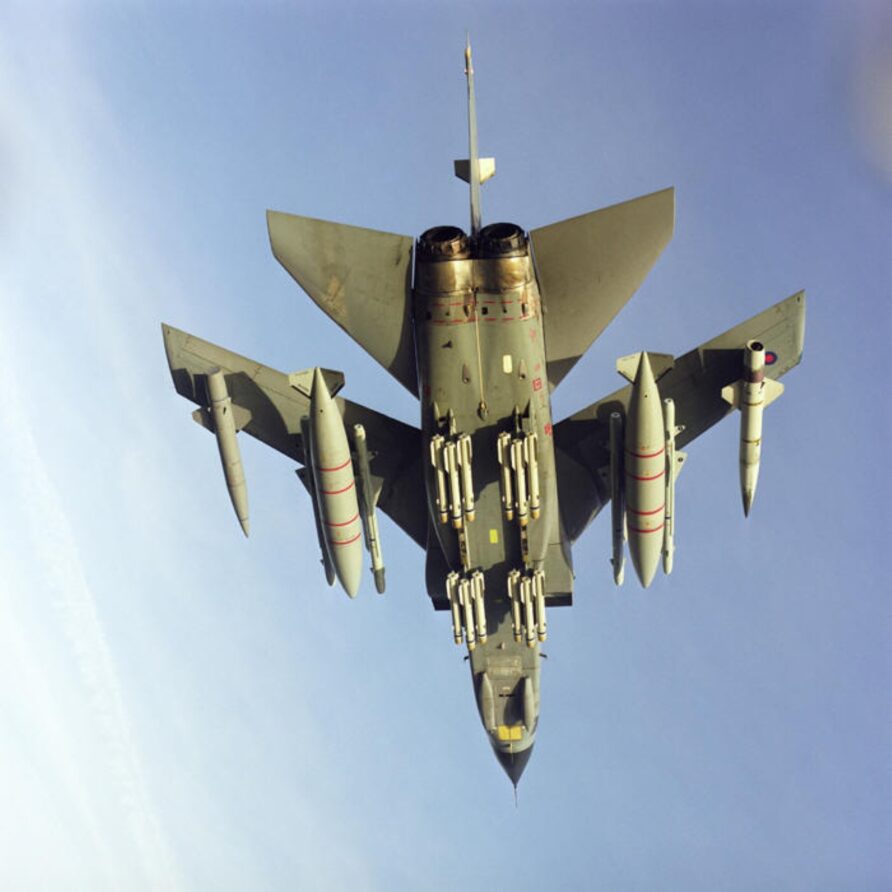
Further firing trials were concluded to achieve the Full Operational Capability (FOC) in December 2005.
During the tests conducted in October 2005 at the China Lake range in California, the missiles were fired against a wide range of different target types, including T-72 and M60 main battle tanks, self-propelled guns, and armored personnel carriers. During these tests, target designation was performed with both head-up displays (i.e., the targets were visually recognized by pilots) and Thermal Imaging Airborne Laser Designator (TIALDs). The missiles were fired in sequences of single missiles, so-called “single-weapon mode,” which is a salvo of three missiles – the load of a single launcher – and in “two-weapon mode,” which is a salvo of six missiles. Of the 31 missiles fired, 30 hit their targets. The official assessment by the UK MoD confirmed the tremendous 96% hit capability, albeit achieved under range conditions (real combat conditions usually show lower hit capabilities for virtually all of the world’s weapon types).
Following the 2005 Defence Industrial Strategy, in 2006, a new approach to managing the design, development, manufacture and through-life support was announced that would adopt a collaborative partnership, with MBDA and the MoD as the lead. Other partners in the team were Thales, Roxel and QinetiQ.
Operations in the Middle East were about to expose the shortcomings of Brimstone.
Operations in Iraq and Afghanistan Demonstrate the Need for Modifications
Brimstone had only been in service for a few years before operations demonstrated the need for modifications.
In Afghanistan and Iraq, the RAF and FAA found themselves without a low-yield precision-guided weapon with a man in the loop to satisfy stringent rules of engagement, and one that could be used against structures or other non-armoured targets. The Maverick missile was available (and used) but it has a very large warhead and so an Urgent Operational Requirement was initiated in 2007 that would see earlier plans for an additional guidance system for Brimstone implemented.
The RAF withdrew its last remaining stocks of BL755 Cluster Bombs in March 2007.
The new variant was to be called the Dual Mode Seeker (DMS) Brimstone, with the development contract issued on the 10th of August 2007. It would retrofit existing missiles with a new Semi-Active Laser (SAL) seeker and a software modification. It retained the ability to operate in either a dual SAL or RF guidance mode, with this selectable in the cockpit.
Dual Mode Seeker Brimstone completed trials in November and October 2008 and entered service with 9 Squadron RAF in December. The first operational sortie was in Iraq, the same month.
Following the first Operational Sortie on 18th December 2008, Flt Lt James Heeps was quoted by UK MoD as saying, “It was an honour for Kenny and I to fly the first operational sortie with this missile; it was the first time a GR4 has been able to check-in with a Joint Terminal Attack Controller with a weapons fit capable of engaging any likely target, including personnel, buildings and particularly, fast-moving vehicles. It was pleasing to see the hard work of industry, 41 Squadron and the relevant IPTs come to fruition.”
Testing continued through 2009.
In 2010, the Ministry of Defence (MoD) signed a long-term partnering agreement with MBDA called the Initial Portfolio Management Agreement (PMA-I). The key objectives of the portfolio partnership were a desire to maximise commonality, promote the reuse of subcomponents, reduce development times improve collaboration with European partners. The agreement covered a spend of approximately £600m each year.
Further details emerged of the various capability block designations.
- SPEAR Capability 1; Raytheon Paveway IV precision-guided bomb and subsequent improvements to include reduced collateral and penetrator warhead and enhanced capability against moving targets.
- SPEAR Capability 2; a 50 kg class powered missile, eventually Block 3, Brimstone 2
- SPEAR Capability 3; a longer-range 100 kg class weapon with the ability to be re-targeted in flight using two-way data links, eventually SPEAR
- SPEAR Capability 4; upgrades to Storm Shadow to sustain it to the OSD
- SPEAR Capability 5; longer range replacement for Storm Shadow
A 2010 Parliamentary answer revealed the development costs of Brimstone and Dual Mode Brimstone
Quentin Davies (Parliamentary Under-Secretary, Ministry of Defence; Grantham and Stamford, Labour)
The cost of developing the original Brimstone Missile System was £370 million. Dual Mode Seeker (DMS) Brimstone was developed as a variant of the original Brimstone system. Development costs specifically for the DMS variant amounted to about £10 million.
Brimstone was removed from the UK’s F35-B Joint Combat Aircraft (JCA) requirement in 2010 and a top-up order was placed for 150 Dual Mode missiles. The MoD also described how each upgrade from Baseline to Dual Mode Brimstone took between 6 and 9 months and cost between £35k and £45k each.
In addition to Iraq and Afghanistan, Brimstone was used to excellent effect in Operation ELLAMY in Libya where it was, for many, one of the standout weapon systems used. There were a few minor problems with DM Brimstone, but they were quickly resolved.
Read more (affiliate link)

Two examples of use in Libya are worth noting, the first was against a regime T-55 tank on the 2nd of July 2011. The tank had sought shelter from air attack in an alleyway in the town of Djebel Nafusa, It was destroyed without damage to surrounding buildings by a single Dual Mode Brimstone.
The second example took place in September near the town of Sebha. A large concentration of regime armoured vehicles was detected and using the Brimstone salvo firing technique, eight vehicles were destroyed in a single attack. Such was the expenditure rate, the RAF’s Brimstone missile stock in the theatre was down to single figures at one point.
Libya also saw the first use of a full 12-missile Baseline Brimstone launch from Tornado.
Although ELLAMY saw the use of the DMB as early as 26th March, shortly before NATO took charge of the no-fly-zone, Millimetric Brimstone was also employed, being fired for the first time in combat during an attack by two GR4s on 15 September during which 22 missiles – including a single salvo of 12 from one aircraft – were launched on pro-Gaddafi armour near Sebha, 400 miles (ca. 644 km) south of Tripoli
Further Spiral Developments
Brimstone 2 was the next evolution of Brimstone.
The new insensitive rocket motor and warhead experienced some early problems with propellant cracking and liner de-bonding, but although they delayed the programme, they were overcome.
Meanwhile, the 500th Dual Mode Brimstone was delivered in February 2012.
A £35m Brimstone sustainment order was placed in November 2013.
With the US Air Force ‘Big Safari’ programme office, MBDA carried out initial firing trials of Dual Mode Brimstone from an MQ-9 remotely piloted aircraft in 2014.
The trials were undertaken on behalf of the UK Ministry of Defence by the Royal Air Force’s Air Warfare Centre Unmanned Air Systems Test and Evaluation Squadron, Defence Equipment & Support Weapons Operating Centre, US Air Force’s BIG SAFARI Organisation, General Atomics Aeronautical Systems and MBDA.
Brimstone was successfully fired from an MQ-9 Reaper RPAS, scoring nine hits out of nine against a range of targets.
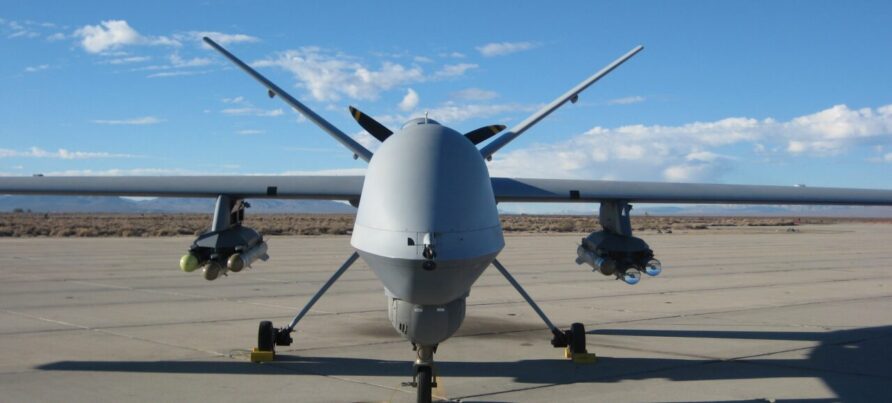
Further trials were completed the same year on Brimstone 2, proving the expanded envelope of this version.
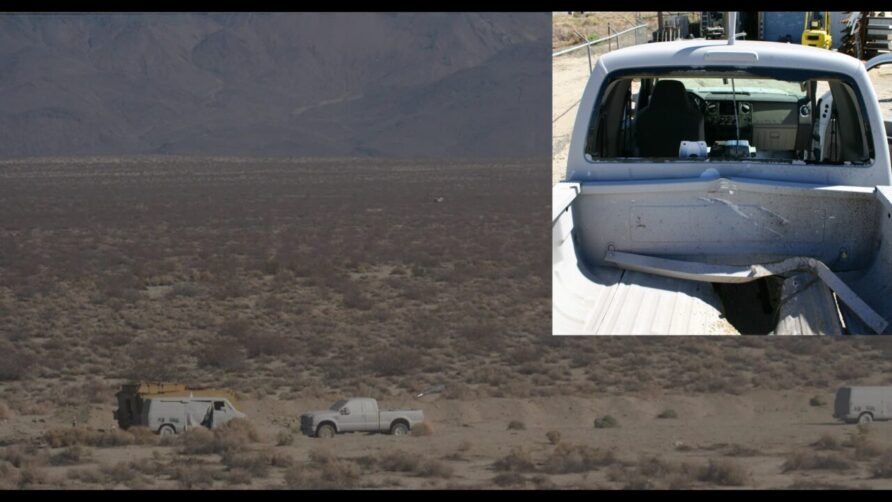
The MoD placed an initial study contract with BAE in June 2014 for the integration of Brimstone 2 onto Typhoon. This contract would also further work on the common weapons launcher that would be used for both SPEAR Capability 3 and Brimstone.
Brimstone 2 entered production in July 2014
Brimstone 2 provides greater operational flexibility by enhancing guidance capabilities against challenging targets and through a step change in IM compliance which significantly improves operator, maintainer, and platform safety on operations and reduces the logistics burden of operational deployments.
The first test fit of Brimstone and Typhoon occurred in December 2014.
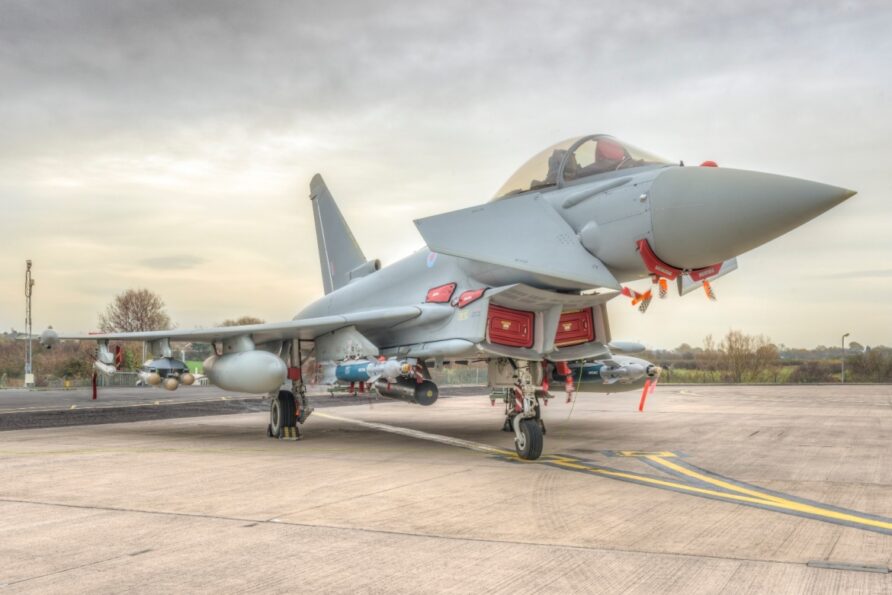
In February 2015, the Typhoon Phase 3 Capability Enhancement contract was let to Eurofighter.
This capability upgrade gives the Eurofighter Typhoon unrivalled full multi-role and swing-role capability. Although the prime focus is the introduction of the Brimstone 2 missile required by the UK RAF, P3E enhances the capabilities of the Storm Shadow long-range strike missile, the Meteor, Paveway IV and ASRAAM weapons, as well as introducing modifications to further improve the aircraft’s already impressive availability. Support for the contract will come from all four core nations and the enhancement package will benefit all who use it
In 2015, RAND published a study on the use of air power during the Libya conflict (Operation ELLAMY) called Precision and Purpose, saying this about Brimstone
To begin with, crews adopted cautious lines of attack to minimize the risk of collateral damage, and other means of mitigating risk also were pursued. Among these was the employment of weapons with an extremely limited effects radius, and the precision-guided munition (PGM) that became the weapon of choice for Tornado crews was the recently developed Brimstone missile. This 50-kilogram PGM had been designed as an anti-armor weapon, and the latest variant (referred to as the Dual Mode Seeker Brimstone, or DMSB), which used laser guidance, proved to be an extremely reliable, accurate, and potent weapon or use against a wide variety of targets, including highly mobile ones. As armor and moving targets were the norm from the beginning of the campaign, the RAF quickly found its stocks of DMSB running low (down to single figures at one point). This was particularly so after it was realized that Brimstone gave the UK a unique capability to strike difficult targets with little or no collateral damage because of the small ize of the weapon and its warhead
The Defence Select Committee Report on Operations Against Daesh detailed the operational use of Brimstone.
The MoD awarded a £1.7m joint contract with BAE, Raytheon and MBDA to research a common weapons launcher for Paveway IV and Brimstone
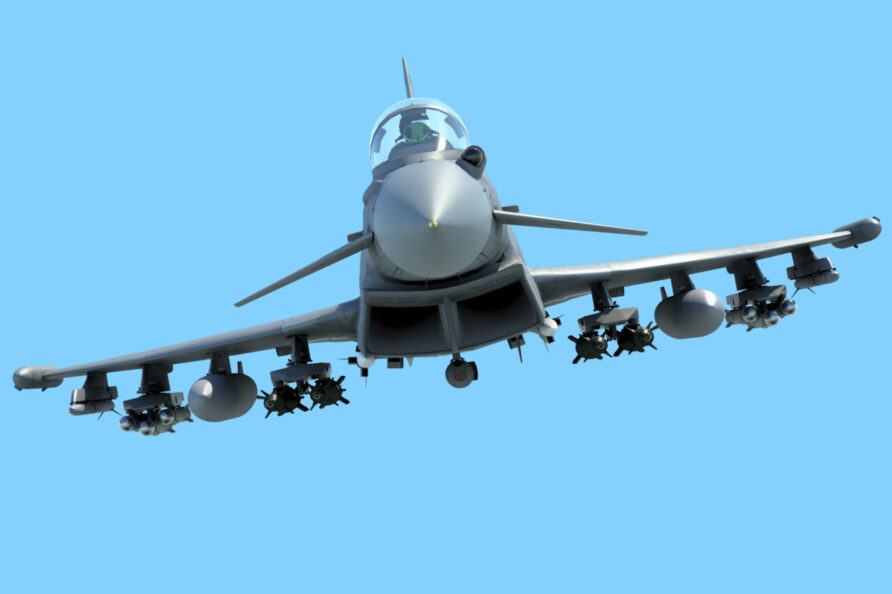
The MoD funded the initial AH-64E integration work with Boeing and MBDA in September 2015.
The programme was funded by a UK Ministry of Defence (MOD) contract, awarded to MBDA in September 2015. It included a range of environmental and sensor compatibility trials, as well as functional and avionic trials to demonstrate new platform software and functionality implemented into the platform and cockpit by Boeing. Boeing performed the platform and cockpit software modifications and managed the trials programme at Mesa and Yuma, Arizona, using a leased United States Government AH-64E in just nine months. All this activity culminated in a number of successful guided firings.
These firings demonstrated the capability of the weapon to guide using Brimstone’s Semi-Active Laser (SAL), Dual Mode SAL/millimetric wave (mmW) and fully autonomous mmW guidance modes. The weapon releases were from hovering, moving and manoeuvring/banking scenarios against Main Battle Tanks and Pickup Truck targets. All of the firings utilised fully telemetered missiles instead of those with a warhead to confirm performance. The UK MOD’s trials objectives were met with missile telemetry being gathered, confirming that the weapons separated with active fin control off the rails, with no tip-off concerns. The data collected from these missile firings will be used to enable future optimisation of Brimstone for the AH-64E capability.
Whilst using the current Brimstone capabilities, and with further enhancements planned, an impressive range of unique capabilities have already been demonstrated. Dan Girardin, Boeing Flight Test Engineer, Mesa AZ: said “The mmW autonomous shot from a moving and banking platform against an off-axis target with the missile hitting the MBT turret ring was the most aggressive shot I have seen in my 30 years of the Apache programme”
In October 2015, the MoD released an Aircraft Statistics document that detailed the number of Dual Mode Brimstone missiles used on Operation HERRICK (Afghanistan)
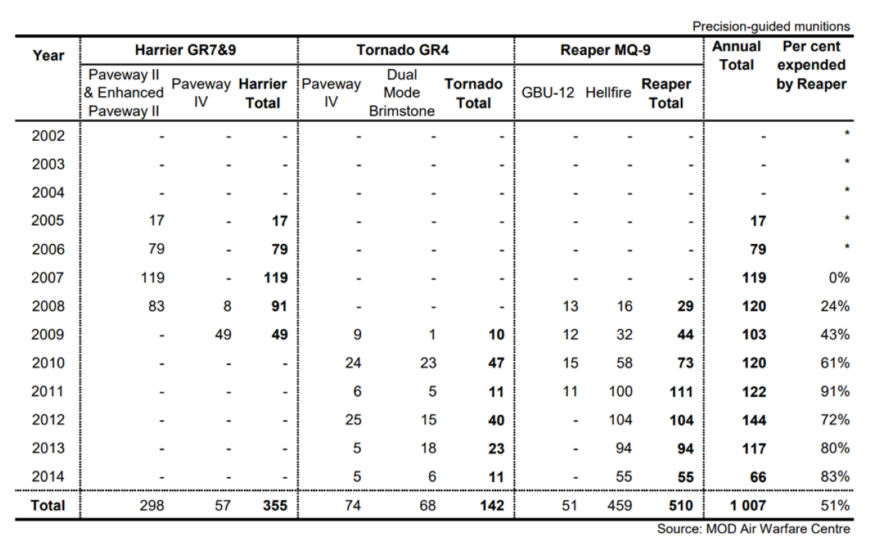
Dual Mode Brimstone was also used against ISIS in Iraq and Syria. In October, November and December 2015, the RAF fired 0, 12 and 9 Brimstone missiles in Iraq and Syria against ISIS.
Brimstone 2 was tested in May 2016, under Project Keme.
During the latest operational evaluation trials, conducted at the US Naval Air Weapons Station, China Lake, California in February this year, GR4 assets from RAF 41 (R) Test & Evaluation Squadron fired 11 Brimstone 2 missiles in a variety of operational scenarios. “The trials focused on demonstrating the overall performance of the missile system with the platform. These included firing missiles at structures, a very small fast moving vehicle, and edge of the weapon system’s performance envelope shots,” an MBDA spokesperson told IHS Jane’s . The spokesperson added that the trials included single and salvo firings, using singe millimetric radar and dual mode guidance, and ground-based third-party laser designation
It entered service in July 2016.
MBDA also released a video of the AH-64E testing in July 2016
A Parliamentary Answer revealed the quantity and costs of Brimstone missiles used during Operation SHADER.
Between November 2014 and 16 September 2016 there have been 230 Brimstone missiles used in Iraq and Syria as part of Operation SHADER. The estimated cost of the use of these missiles is £18.7million.
The first firing of a Brimstone missile from a Typhoon was achieved in July 2017
BAE commented on this milestone;
Brimstone is part of the Phase 3 Enhancement (P3E) package which also includes mission system and sensor upgrades. P3E is the final part of Project Centurion – the programme to ensure a smooth transition of Tornado GR4 capabilities onto Typhoon for the RAF.
Commenting on the continuing trials work, Steve Formoso (BAE Systems Military Air & Information Chief Test Pilot) said:
“This series of flight trials has included Aero Data Gathering (ADG) flights to test how the addition of the Brimstone weapon and other assets interacts with the aircraft’s flight control system software. The results have been excellent, with the pilot maintaining manoeuvrability whilst carrying a heavy weapons load. The detailed results of these trials will now be analysed and further testing carried out ahead of firing trials. The low collateral Brimstone will provide the Typhoon pilot with the ability to precisely attack fast moving targets at range, further enhancing the aircraft’s already potent air-to-surface capabilities.
In March 2018, the MoD issued a £400m Brimstone Capability Sustainment contract with MBDA
The United Kingdom has awarded MBDA a £400 million contract for the capability sustainment programme (CSP) of the advanced Brimstone air-to-surface missile, to extend its service life beyond 2030.
Under the CSP effort, MBDA will manufacture new Brimstone missiles for the UK Armed Forces in order to replenish the country’s inventory and to maintain the UK’s battlefield edge into the future. The new-build Brimstone missiles will incorporate all of the improved functionalities offered by the spiral upgrades of Brimstone that have taken place over recent years in order to meet UK operational requirements. These include the highly capable Dual Mode SAL/millimetric wave (mmW) seeker, enhanced autopilot, and the new insensitive munition compliant rocket motor and warhead.
The effort will also include a significant memory and processing update to the missile in order to enable all of Brimstone’s functionalities and to future-proof the missile. Brimstone CSP will deliver the baseline hardware standard that will be evolved through software enhancements which will result in a common stockpile of identical missiles for use on fast jets, attack helicopter and remotely piloted aircraft systems (RPAS) for the UK MoD and will enable the manufacture of Brimstone to meet export orders. CSP modes will be cockpit selectable providing users with simple access to the unique performance capabilities of Brimstone against the most challenging of targets.
Chris Allam, MBDA Group Engineering Director and Managing Director of MBDA UK, said: “I am delighted that the UK has chosen to proceed with the Brimstone capability sustainment programme. This new investment by the UK is an endorsement of the unique and world-beating capabilities offered by Brimstone. The CSP contract forms the basis for the through-life sustainment and upgrade of Brimstone to 2030 and beyond.”
Brimstone will be carried by the Royal Air Force’s Typhoon fighter aircraft and is expected in the future to be carried by the RAF’s new Protector RPAS and the British Army’s new Apache attack helicopters. By using Brimstone across different platforms and services, the UK will receive significant logistical advantages and cost savings
Brimstone CSP would later be designated as Brimstone 3A (B3A)
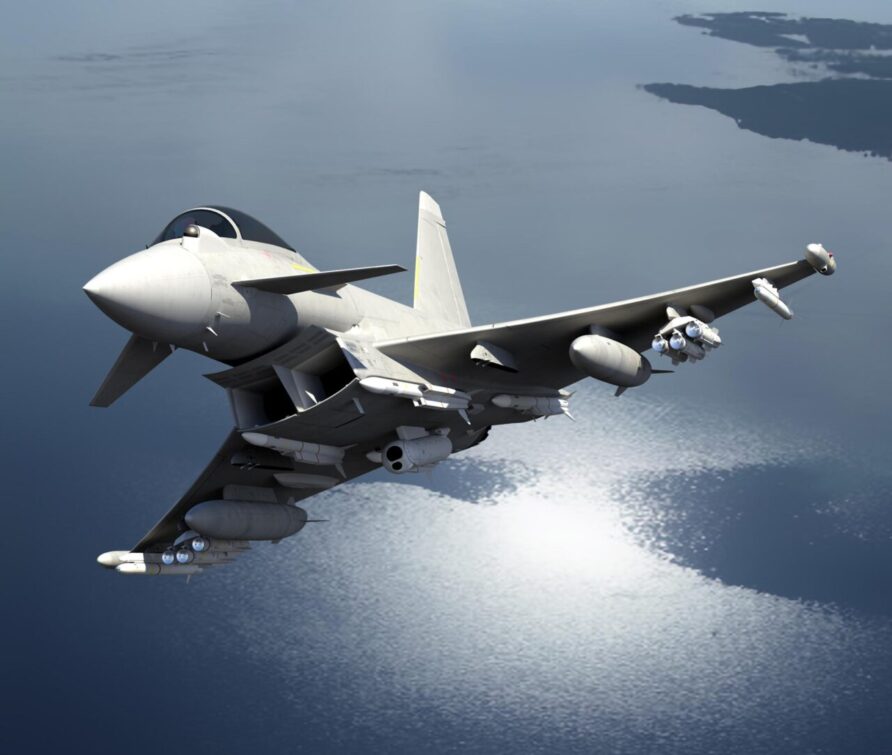
General Atomics Aeronautical Systems Inc (GA-ASI) awarded a contract to MBDA at the end of 2018 to support the integration of Brimstone 3 onto the RAF’s future Protector RG Mk1 remotely piloted air system (RPAS).
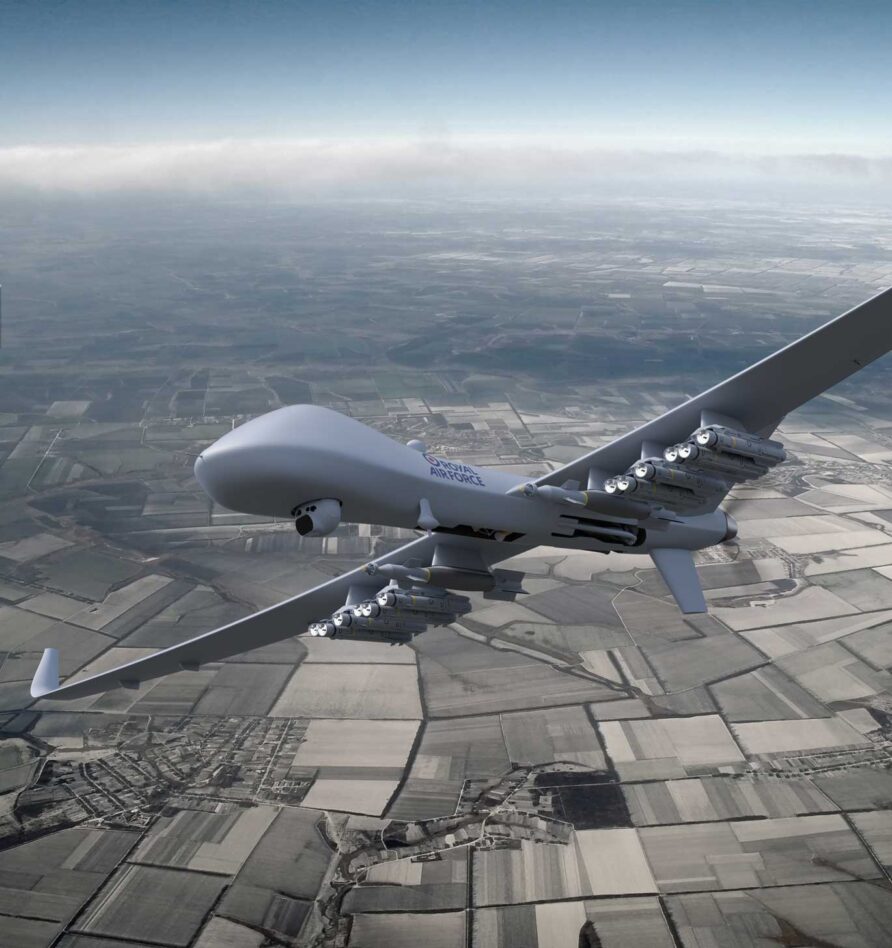
In March 2019, the first Brimstone 3 missile completed its first firing from a ground-based launcher
The Brimstone 3 ultra-high precision missile system has successfully achieved a major milestone by completing its first firing trial at the Vidsel Trials range in Sweden. Whilst enduring extreme weather conditions with temperatures below -30°C, the missile was surface launched against a pick-up truck target. All trials objectives were fully achieved with the missile proving, through a telemetry unit, full closed loop guidance with the seeker progressing into target acquisition and track.
MBDA released a video of this first firing.
The first operational firing of a Brimstone missile from an RAF Typhoon was carried out on the 19th of February 2019 against a boat on the River Euphrates used by ISIS fighters.
Tornado was withdrawn from service in March 2019, leaving Typhoon as the only aircraft in RAF service capable of firing Brimstone.
In 2020, the RAF released images of Brimstone on the Protector RPAS undergoing ground vibration testing.
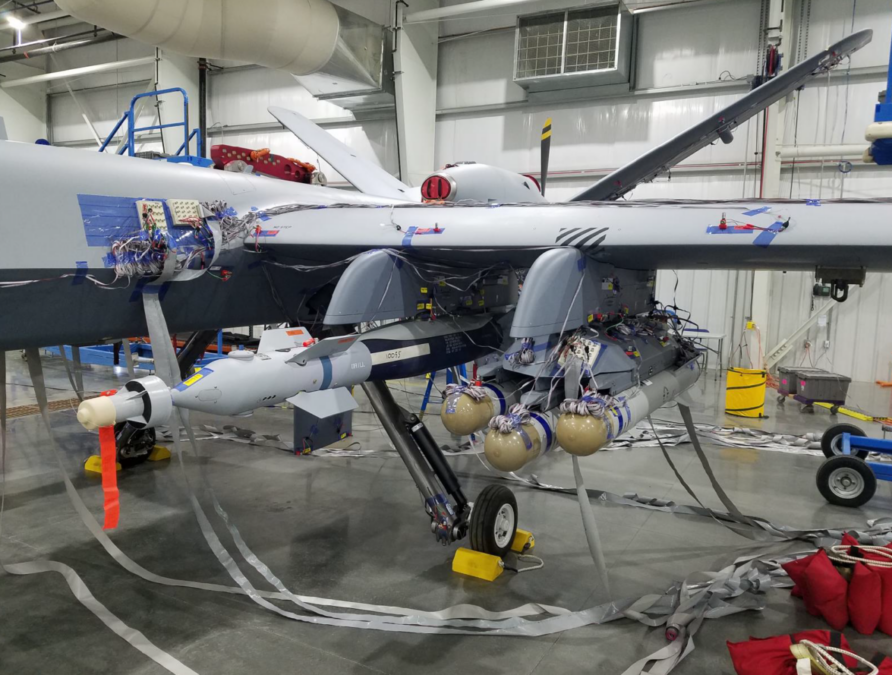
Although not formally announced, the MoD placed a £197m Demonstration and Manufacture contract with MBDA in April 2020 for Brimstone 3B (B3B).
B3B was for a software upgrade that would be integrated with the B3A project.
In June 2021, the MoD confirmed the Joint Air to Ground Missile (JAGM) would be used on Army Air Corps AH-64E Apache attack helicopters instead of Brimstone 3.
The Joint Air-to-Ground Missile (JAGM) for the new AH-64E Future Attack Helicopter has been selected. This missile is designed for helicopter use and is already integrated within the aircraft, simulators and mission planning systems. In addition to JAGM, the Hellfire K1 and Hellfire Romeo missiles will also be fully qualified and integrated onto the aircraft.
The Labour Party were less than impressed
My right hon. Friend the Member for Warley mentioned Hellfire, the latest scandal. This relates to the new missiles for the Apache helicopters. There were two competitions: the joint air-to-ground and Hellfire missiles; and the Brimstone weapon, to which he referred. Brimstone is an effective weapon which the Americans wanted to purchase, but they were stopped by Congress. So what do you think the MOD did? Did it buy British and ensure this proven technology for our Apaches? No—it has just awarded the contract for Hellfire and JAGM to the United States, which again is exporting UK jobs. The issue with JAGM, and I have raised this with the MOD, is that it is not even at the moment, I understand, fully IM—insensitive munition—compliant, unlike Brimstone.
A March 2022 Written Answer provided further context for the JAGM decision
Kevan Jones Labour, North Durham
To ask the Secretary of State for Defence, what the basis is for the £120 million savings declared for Brimstone integration in the Defence and Equipment Plan.Jeremy Quin The Minister of State, Ministry of Defence
The bulk of the savings relate to the fact that notwithstanding the Department’s significant confidence in Brimstone and its ongoing development, the decision was taken to field the Joint Air-to-Ground Missile onto Apache. This decision expedited a solution for a capability gap faster than could be achieved through the Brimstone 3 option.
Many analysts were unconvinced by this answer.
The Defence Equipment Plan, published in February 2022, revealed the in-service date for Brimstone 3A had slipped to 2024, and that despite JAGM being selected for AH-64E, it would be retained for Typhoon as part of routine stockpile management.
Brimstone 3B would enter service with Typhoon and Protector.
The same report also described the savings from utilising JAGM on AH-64E instead of Brimstone 3 were ‘less than £99m in the current review period’
In October 2023, the Defense Security Cooperation Agency published a notification of a possible same of JAGM to the UK.
WASHINGTON, October 23, 2023 – The State Department has made a determination approving a possible Foreign Military Sale to the Government of the United Kingdom of Joint Air-to-Ground Missiles (JAGM) for an estimated cost of $957.4 million. The Defense Security Cooperation Agency delivered the required certification notifying Congress of this possible sale today.
The Government of the United Kingdom has requested to buy three thousand (3,000) Joint Air-to-Ground Missiles (JAGM), AGM-179A. Also included are dummy missiles; technical assistance; publications; integration support; and other related elements of logistics and program support. The total estimated program cost is $957.4 million.
Ukraine and Beyond
Negotiations commenced with Ukraine for the supply of Maritime Brimstone (Sea Spear) in October 2021.
On April 19th, Boris Johnson (UK Prime Minister) said
One of the systems that we’re looking at … is to see if we could mount some Brimstones on the back of technicals (vehicles) to see if that will do the job
In May 2022, reports of Brimstone use in Ukraine started to appear online.
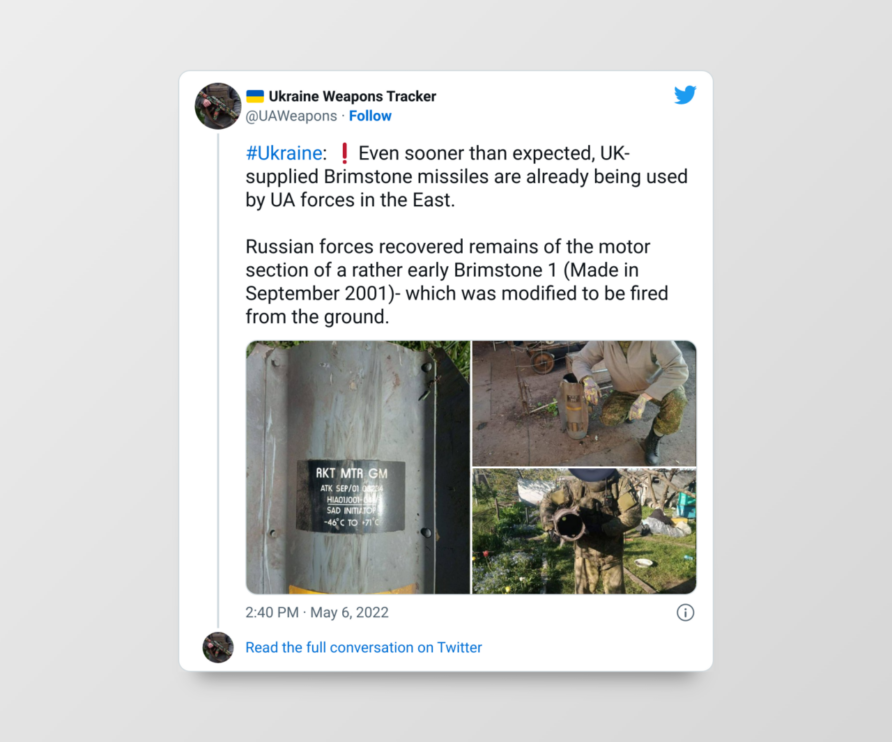
and
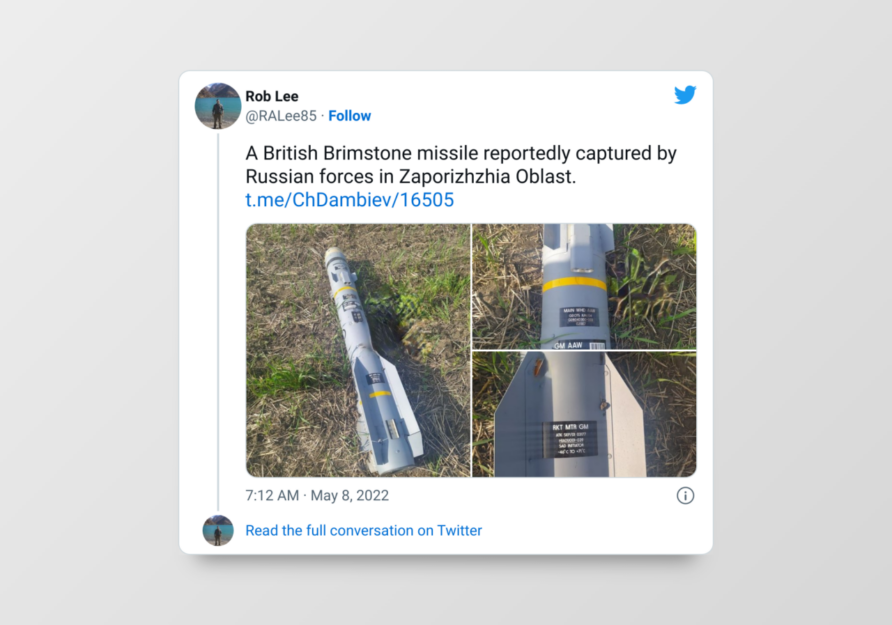
The second Tweet above was subsequently reported to be incorrect, it wasn’t captured.
Video footage soon emerged of Brimstone in use, fired from a truck that appeared to use the mounting frame and three-round Cobham launcher used for tests and trials.
The additional image below shows Maritime Brimstone trials for comparison.
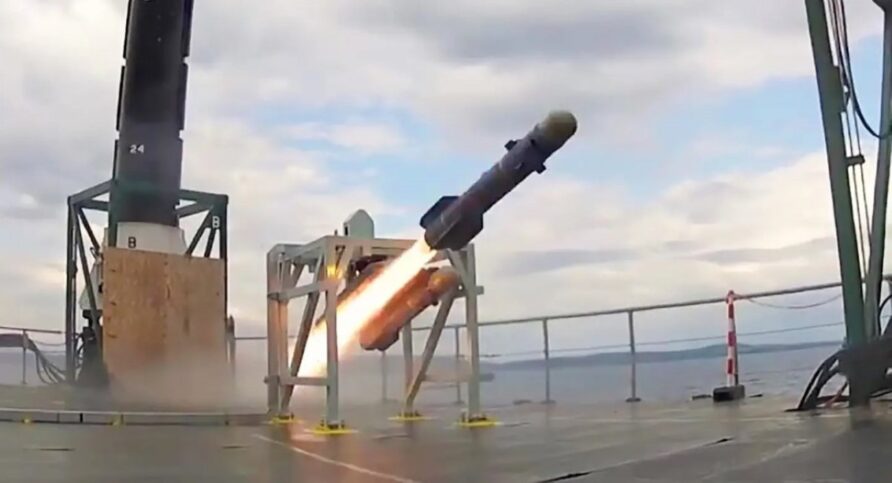
A July 2022 Written Answer confirmed that both Brimstone and Maritime Brimstone had been supplied to Ukraine.
Video footage emerged in the latter half of 2022 of Brimstone being launched in Ukraine
Additional video footage from BFBS in October 2022 confirmed Brimstone 2 deliveries to Ukraine.
There was some press speculation in July 2023 that the UK was supplying Project Wolfram vehicles to Ukraine although this was not confirmed.
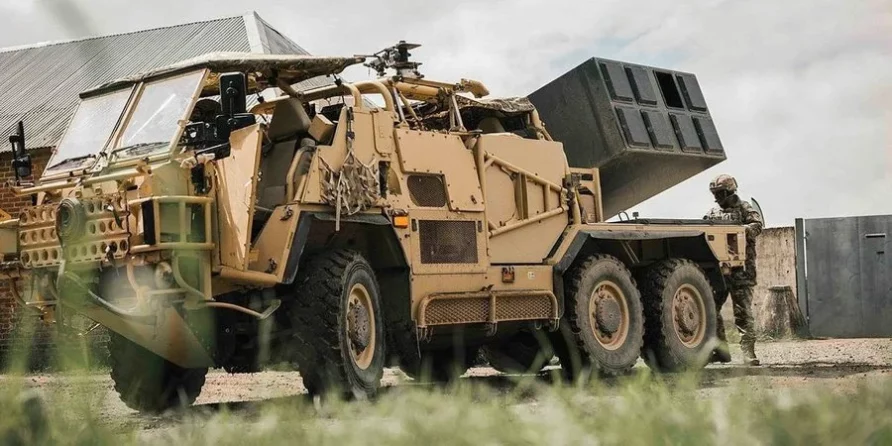
Spain confirmed it would integrate Brimstone 3A onto its Typhoon in July 2023, with Germany following suite in 2024, the latter reportedly establishing a production line.
In a written response to the Defence Select Committee report, ‘Ready for War’, in April 2024, the MoD stated
To date investments include support to deliver a large purchase of 155mm munitions, building storm shadow stockpiles, supply chain mapping, wargaming, enhancements to a range of critical infrastructure, and medical stockpiles.
In addition to these uplifts, we have placed almost £1Bn in contracts to replenish UK stocks of equipment and munitions already granted to Ukraine. Contracts have been placed to replenish UK stockpiles include Next Generation Light Anti-Tank Weapons; Starstreak High Velocity Missiles; Lightweight Multirole Missiles; Javelin missiles; Brimstone missiles; 155mm artillery rounds; and 5.56mm rifle rounds
It was not clear if the Brimstone reference was over and above that already included in contracts described above.
Before reading on, would you mind if I brought this to your attention?
Think Defence is a hobby, a serious hobby, but a hobby nonetheless.
I want to avoid charging for content, but hosting fees, software subscriptions and other services add up, so to help me keep the show on the road, I ask that you support the site in any way you can. It is hugely appreciated.
Advertising
You might see Google adverts depending on where you are on the site, please click one if it interests you. I know they can be annoying, but they are the one thing that returns the most.
Make a Donation
Donations can be made at a third-party site called Ko_fi.

Think Defence Merch
Everything from a Brimstone sticker to a Bailey Bridge duvet cover, pop over to the Think Defence Merchandise Store at Red Bubble.
Some might be marked as ‘mature content’ because it is a firearm!
Affiliate Links
Amazon and the occasional product link might appear in the content, you know the drill, I get a small cut if you go on to make a purchase
Brimstone Capabilities
Every single iteration of Brimstone has only ever added capability, none has been removed.
Baseline Brimstone
Brimstone certainly has a common design root with Hellfire, but by the time it entered service, very little commonality remained (just the guidance fin assemblies, I think). The G loading, surface friction and speeds involved with supersonic launch made the engineering much more challenging and so although the original plan might have been to put the millimetric wave radar onto the front of a Hellfire, that is not how it turned out.
Brimstone has a solid rocket motor that allows it to fly at a maximum speed of Mach 1.8.
.At 48.5 kg, 178 mm in diameter and 1.8m long, it is a compact weapon that has a tandem warhead to defeat reactive armour. The 300g precursor warhead is tilted at a downward angle to make it more effective against reactive armour, and the main warhead weighs 6.2 kg.
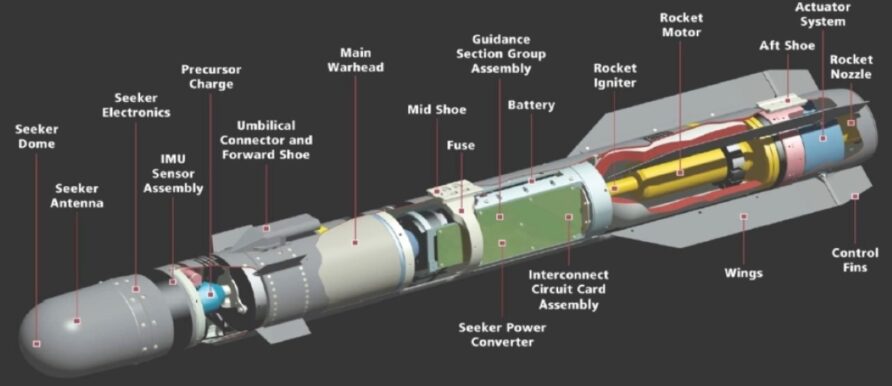
Operating at the near optical wavelength of 94 GHz, the Millimetric Wave (mmW) seeker provides a very high-resolution radar image of the target that allows the number of target recognition algorithms to determine whether a return is a tank (and what type) or a tree.
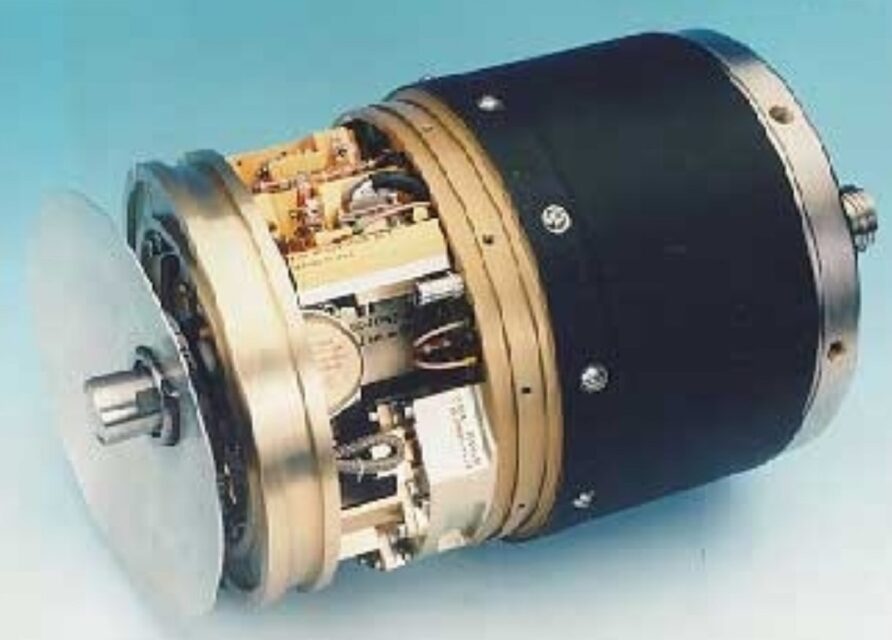
In an age where we are all used to seeing videos of laser-designated targets being destroyed, it is easy to lose sight of just how brilliant the first iteration of Brimstone was (and is).
Right from the outset, it was designed for indirect and direct attack modes (keen-eyed readers may also note there is an attack helicopter in these early GEC Marconi images!)
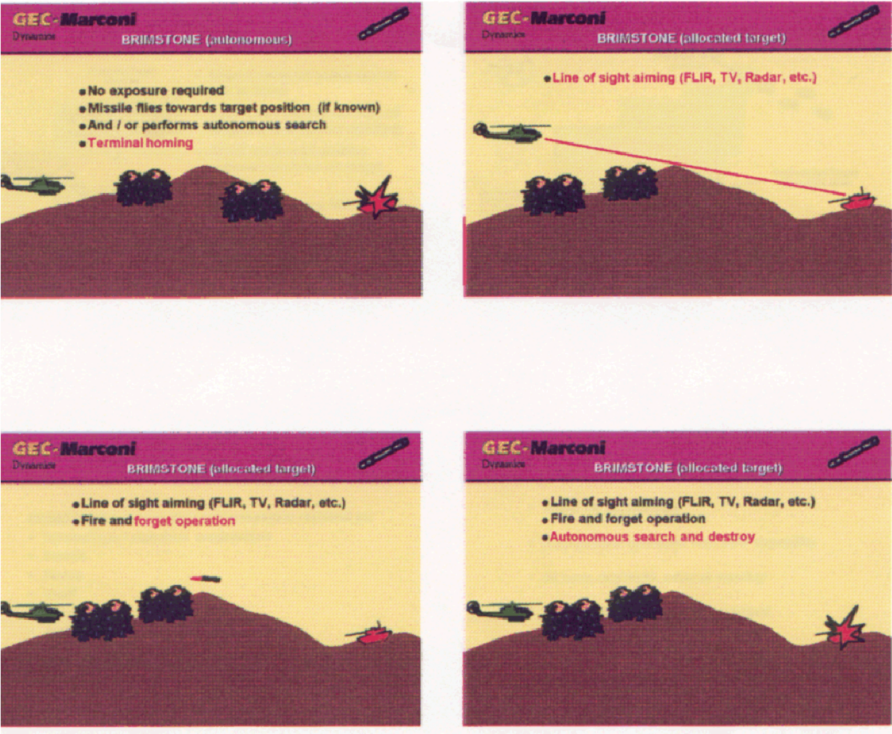
The flight profile below illustrates the general concept.
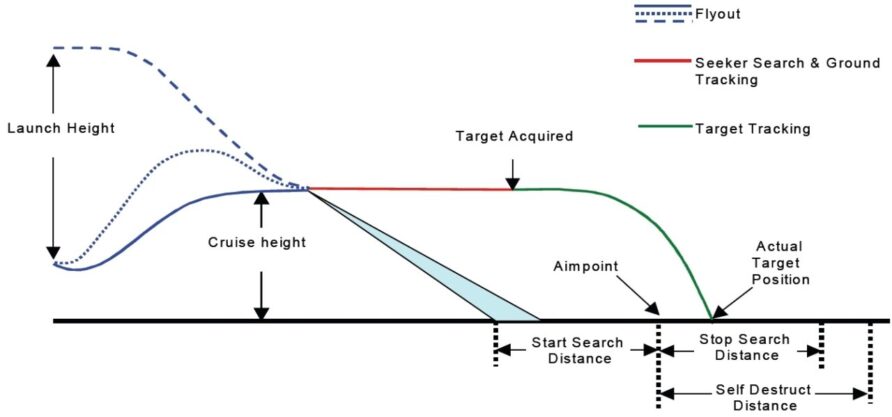
The pilot enters the target search area coordinates, altitude, search and stop search distance, self-destruct distance and attack mode. The target area can be received from offboard sources or entered directly.
The aircraft passes relevant data to the missile, and it is then launched, after which it either descends or ascends to cruise height.
Brimstone has a unique salvo launch capability, three at a time from each launcher, with multiple launchers in quick succession. The video below provides a good illustration of this.
It is then flown to the search area using its autopilot and INS.
The missile can be set to only search for targets after it reaches a given point, allowing it to overfly friendly forces safely, the Start Search Distance point. It can also be programmed to stop searching beyond the safe engagement area or to only accept a target in a certain area, a definable self-destruct distance is also programmable.
When released, the weapon is fully autonomous, allowing the launch aircraft to turn away to safety, leaving the missile to get on with the job. When the start search point is reached, the radar seeker starts searching for the target.
The radar ‘images’ the target area, comparing the return with a library of targets held in its computer system. The algorithm can not only determine the difference between a tank, truck, building, tree or missile TEL, it can select the optimum point of impact according to the target type. This also allows it to reject targets based on defined parameters.
There are three attack modes available
Point attack; this can be direct or indirect and use any number of available missiles
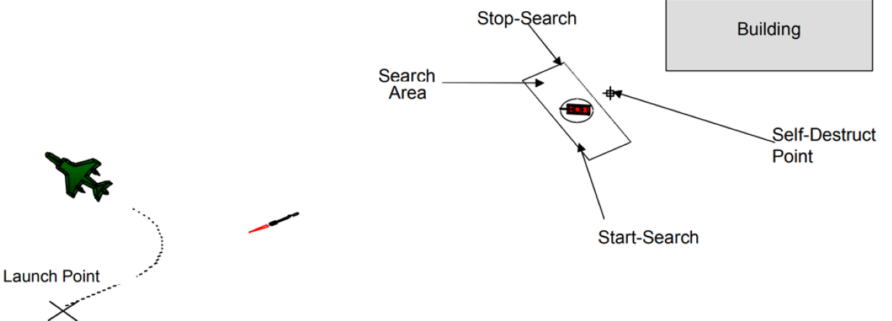
Area Attack; uses between 3 and 12 missiles, with the missiles generating a different target set based on position, weapon number and release order.
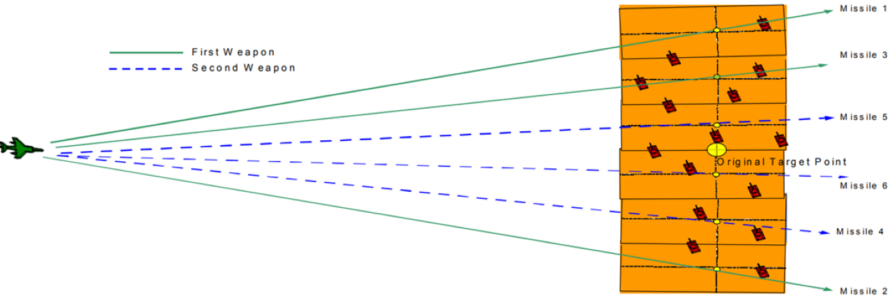
Column Attack; uses between 3 and 6 missiles, each missile attacks the column in sort order

Using a millimetric radar system also confers immunity from target obscuration due to weather and light conditions. The radar has a very narrow emission angle to reduce signatures and the possibility of intercepting and jamming.
Baseline Brimstone was(is) integrated on Tornado and Typhoon, not Harrier.
Dual Mode Seeker Brimstone (DMS-B)
DMS-B was a component and software upgrade.
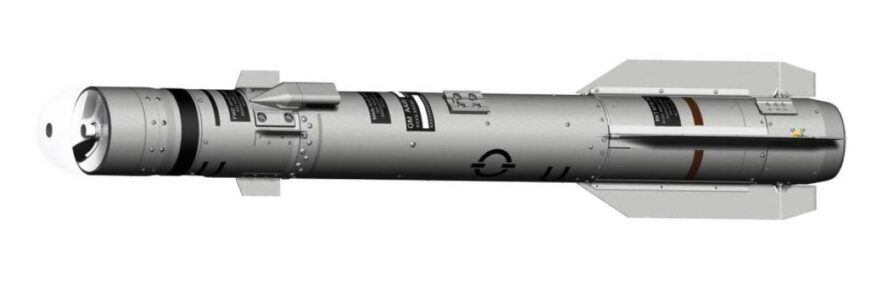
The existing millimetric wave radar seeker is replaced with a design based on the original, but with the addition of a Semi-Active Laser (SAL) seeker. Despite the name, Dual Mode Seeker Brimstone can actually operate in three modes.
- Original mmW only
- SAL only
- Dual mmW/SAL
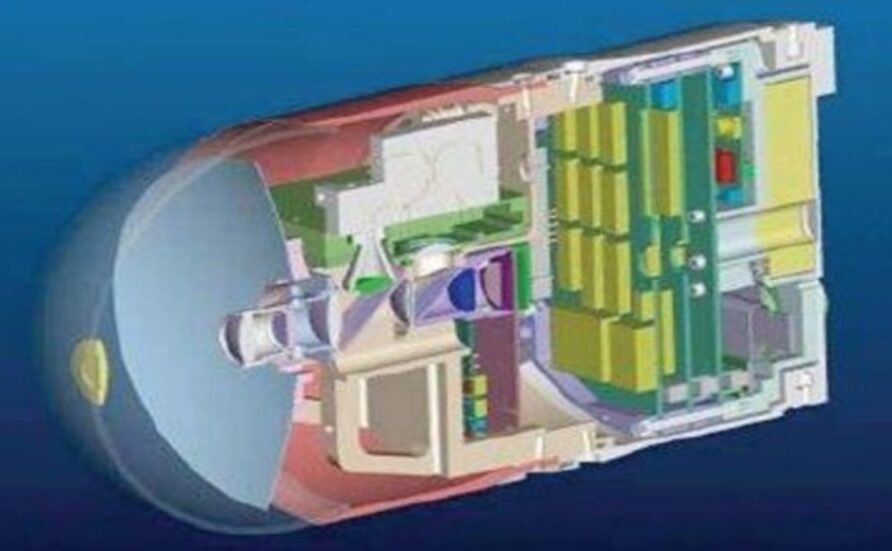
The seeker (above) is combined with the digital autopilot and Internal Navigation System (INS)
Brimstone 2
Brimstone 2 had a new modular airframe to facilitate upgrades and maintenance, and the enhanced dual mode (radio frequency (RF)/semi-active laser (SAL) seeker from Dual Mode Brimstone.
The missile energetics were replaced with IM-compliant designs.
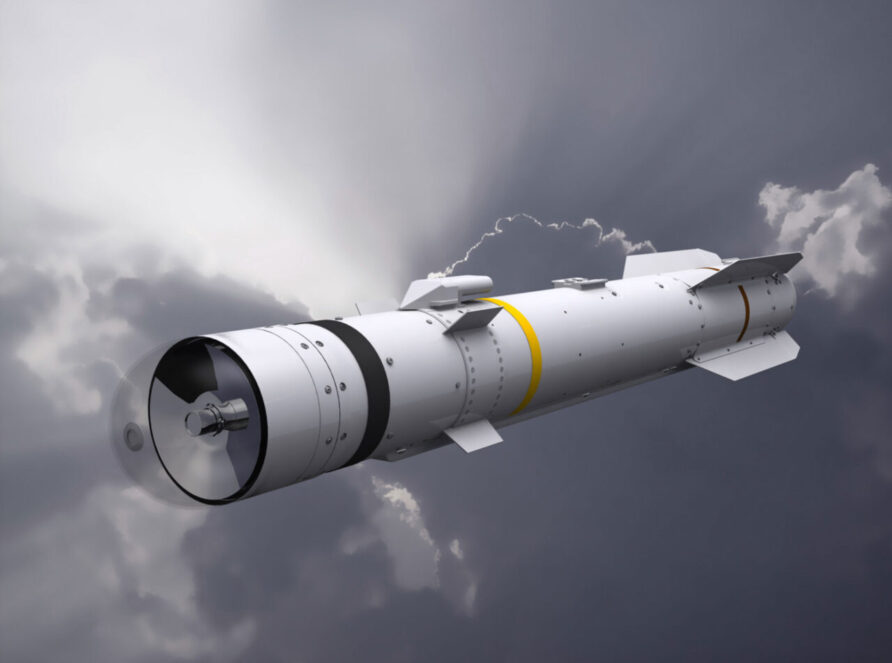
The Vulcan Rocket Motor from Roxel provides an insensitive and extended range capability for Brimstone 2
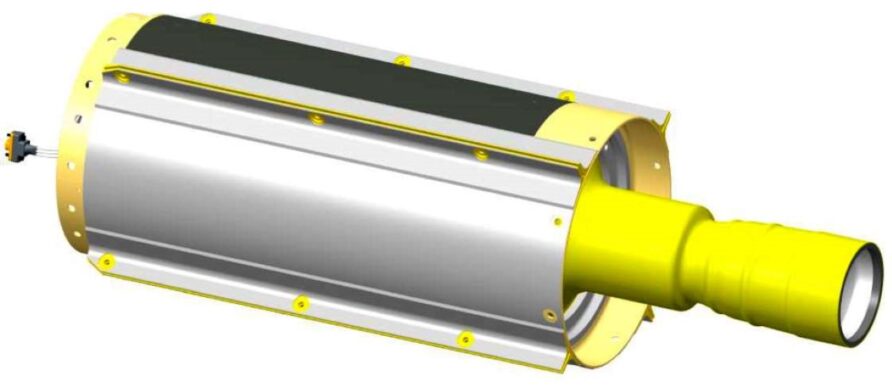
Despite the initial problems, the new rocket motor is a significant achievement.
The multi-effects warhead was developed by MBDA subsidiary TDW in Germany, contributing to an increase in overall weight.
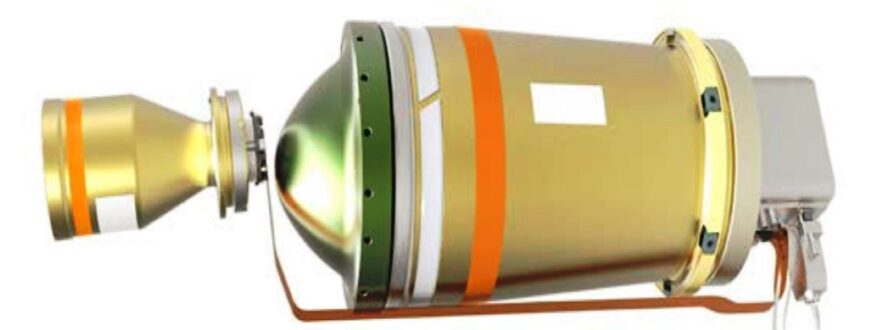
Brimstone 2 also improved the engagement envelope with a greater than 200% increase in off-boresight and range envelope, although the actual range officially remained the same as Dual Mode Brimstone. Enhanced laser and dual-mode performance, especially against low reflectivity targets in highly cluttered environments, was also part of the improvement package
Brimstone 2 was integrated with Typhoon in the P3E series of enhancements that also included Storm Shadow integration, all managed under Project CENTURION.
Maximum carriage is 12 Brimstone 2 missiles.
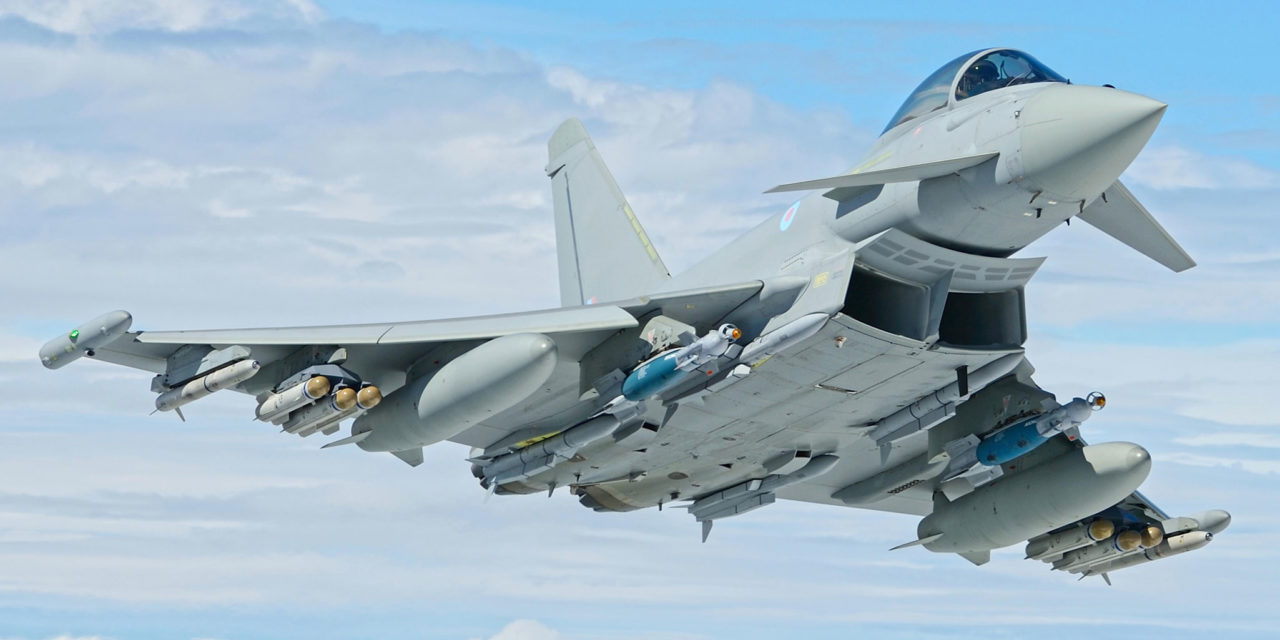
Brimstone 3
Brimstone 3 is a new build missile that incorporates all the previous spiral developments into a single, consistent standard.
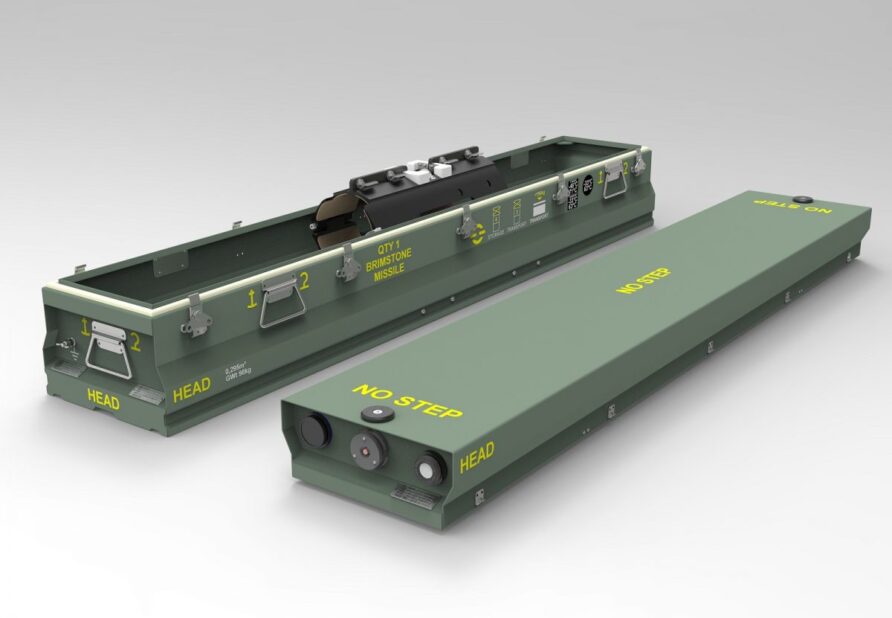
In the period between Brimstone 2 and 3, MBDA proposed a variant of Brimstone 2 for AH-64E Apache. The warhead was to be optimised for non-armoured targets (without losing any anti-armour performance), have a cockpit-selectable trajectory, which allows line-of-sight engagement (flat trajectory) and high and low missile flight profiles to avoid close-in obstacles; a cockpit-selectable capability that allows the pilot to determine the elevation and impact angle on the target to maximise weapon effect; and a new set of warhead modes, which includes delayed, airburst, impact, and proximity fuzing.
This was designated Future Attack Helicopter Weapon (FAHW).
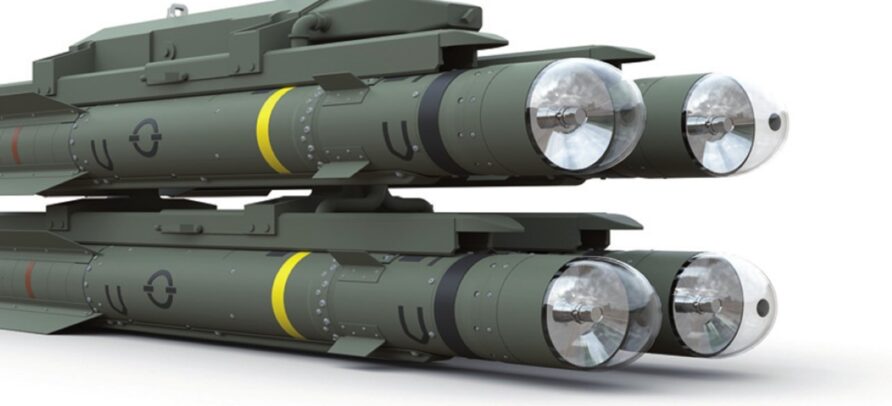
Brimstone 3A retains all the critical components from Brimstone 2

B3A enhancements include a new microelectromechanical system (MEMS)-based tactical inertial measurement unit (IMU) developed by Atlantic Inertial Systems (AIS) and a new enhanced autopilot for improved precision at extended ranges.
An improved battery provides an additional 30% engagement duration.
TDW also developed an improved multi-effect warhead for Brimstone 3 that was designed for use against various targets, as shown in the image below.
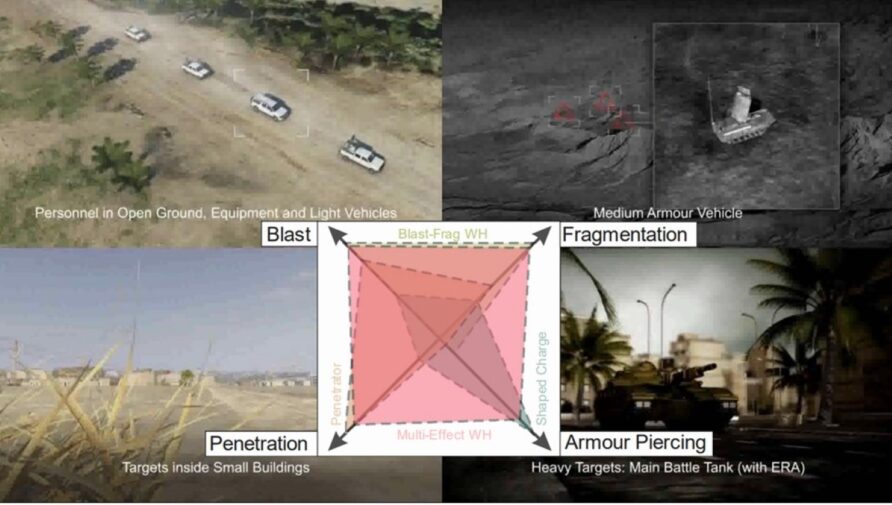
It could also be used in a number of modes, also as shown in the image below.
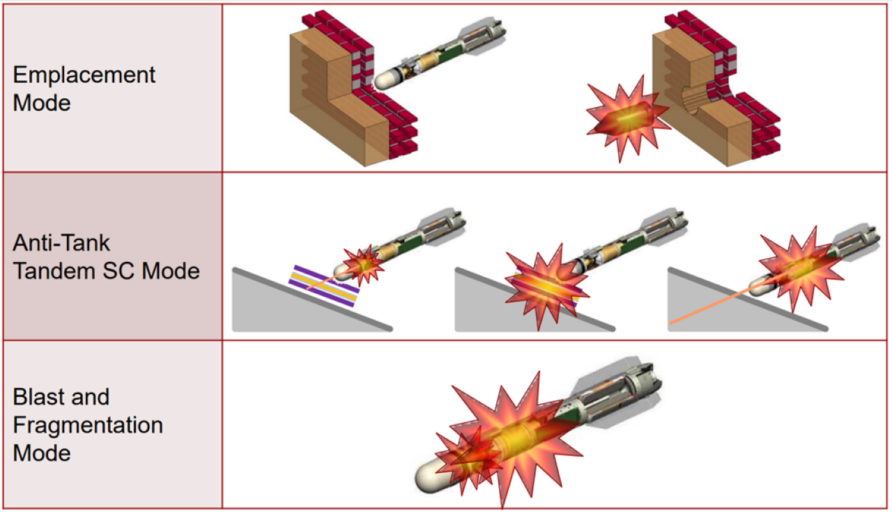
This new warhead was also fully compliant with STANAG 4439 for IM.
Carriage and Launch Pylon
The Cobham/Eaton Air to Ground Missile Launcher (AGML III) is the latest iteration of the original launcher. A single weapon was described as the launcher and three missiles, together weighing 235 kg.
Typhoons can carry 4 ‘weapons’ for a total of 12 missiles and Protector is described as able to carry six weapons, for a total of 18 missiles.
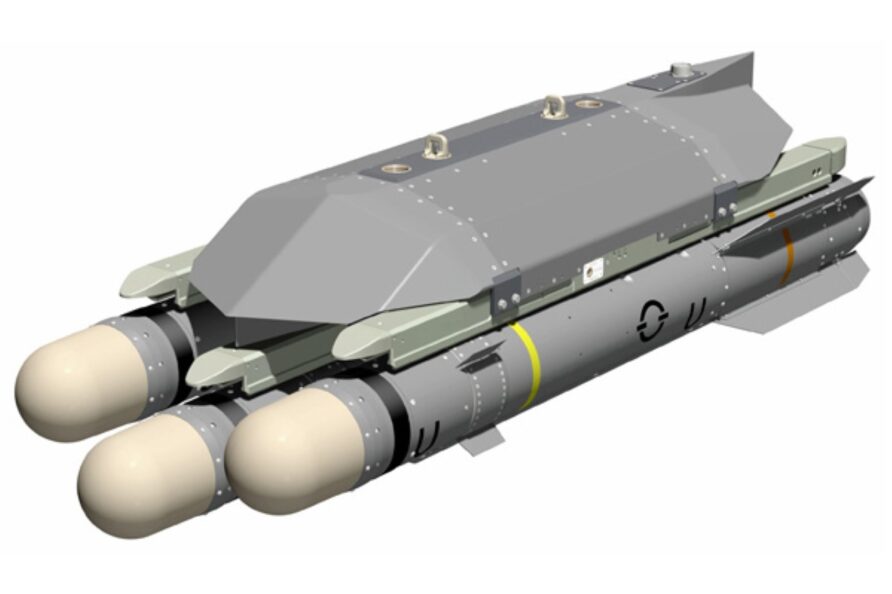
The same launcher can also be used to carry two Paveway IV
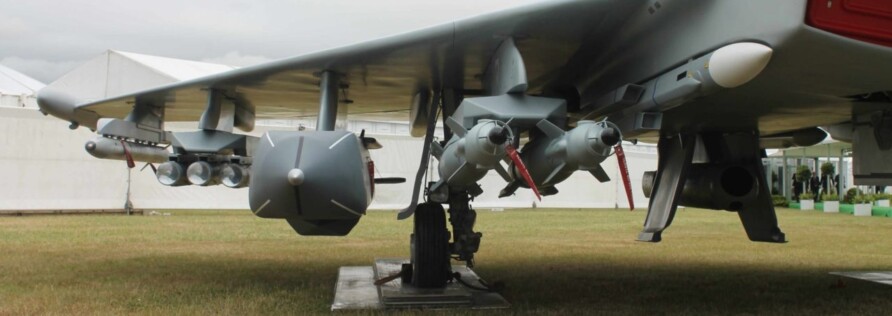
A lighter version called Cobra is also available, with one or two launch rails.
A couple of manufacturer mock-ups have also been shown using the triple rail launcher on a heavy lift UAS, such as this from Hydra Drones.
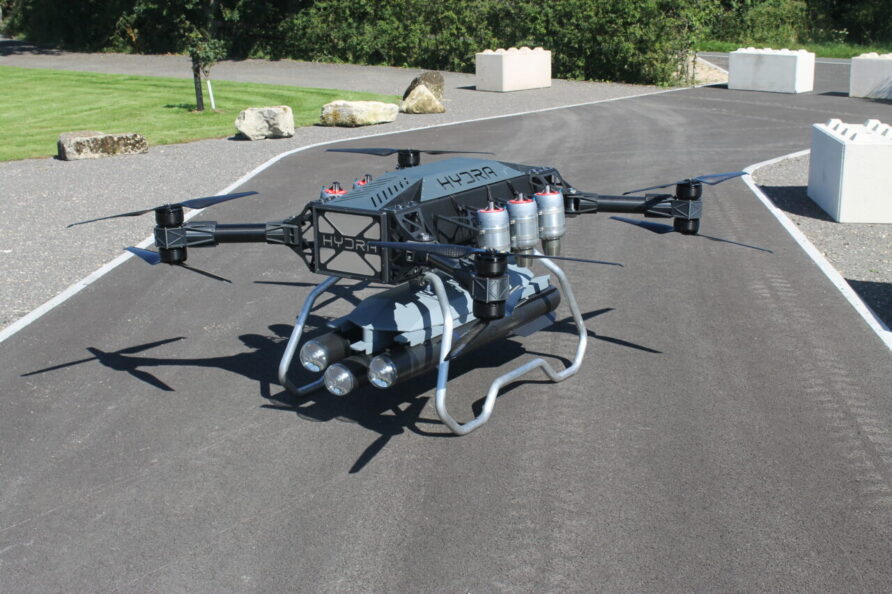
Maritime Brimstone (Sea Spear)
Not long after Brimstone entered service the target library was expanded to include various maritime targets and when Dual Mode Seeker Brimstone entered service years later, the dual mode capability was configured to enable use against small fast-moving low reflectivity boats.
Between 2012 and 2014, the RAF, MBDA and QinetiQ carried out several trials against single and multiple surface targets.
The mmW used with the SAL seeker provided a very high-accuracy solution. The tests were expanded, with larger and faster small craft.
Dual Mode Brimstone had a demonstrable anti-FIAC capability from 2013, but this was air-launched. The next evolution was to fire it from a surface platform.
A jack up leg platform was used as a surrogate coastal position or naval vessel during trials.
MBDA described this as;
Multiple Brimstone missiles operating in an autonomous millimetric wave (MMW) mode completed the world’s first single button, salvo engagement of multiple FIAC, destroying three vessels (one moving) inside a kill box, while causing no damage to nearby neutral vessels.
The marketing term ‘Sea Spear’ was used.
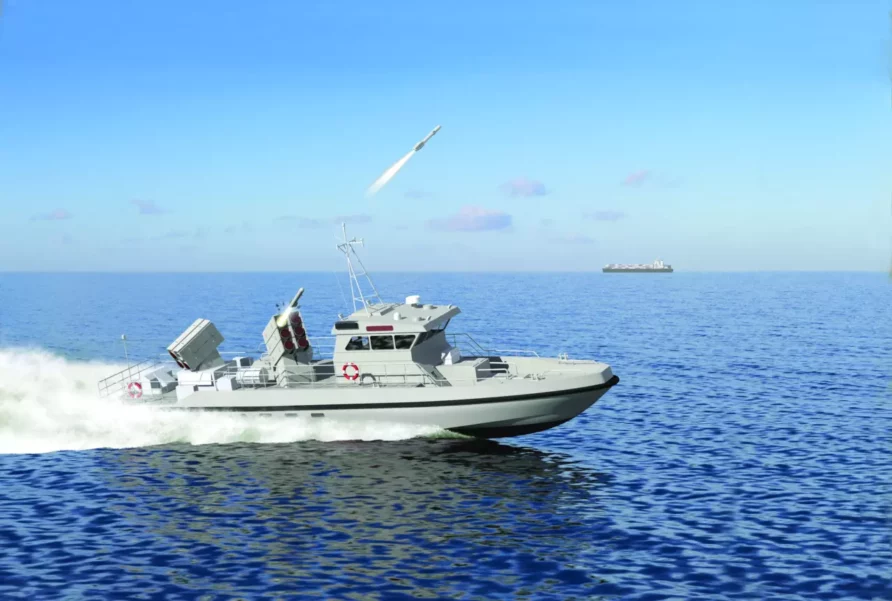
MBDA combined Brimstone with other missiles in their portfolio, either as Sea Ranger or Compact Warfare System Package (CWSP), either for small or medium-sized patrol craft.
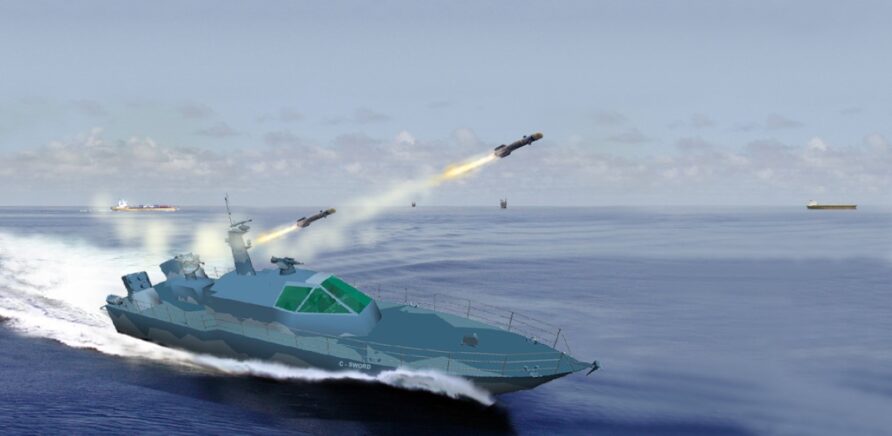
MBDA now market the missile as Maritime Brimstone.
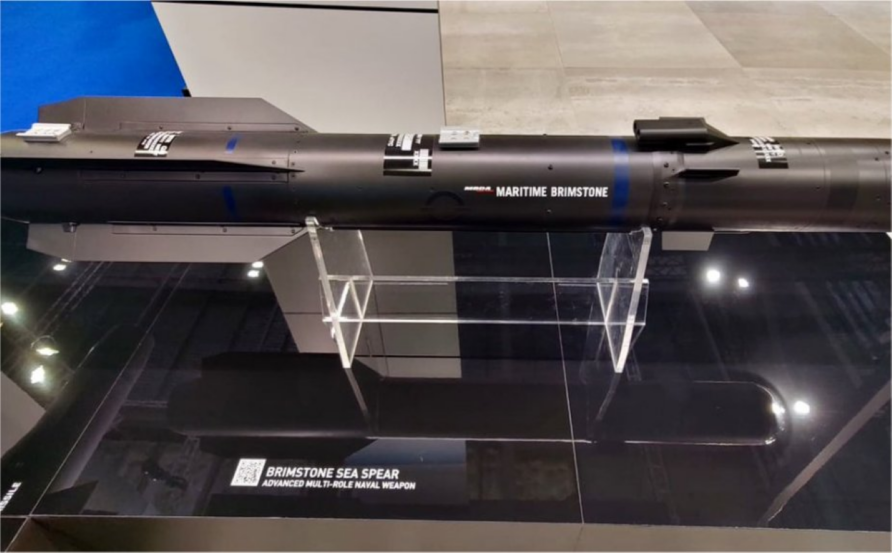
It is assumed Maritime Brimstone will be supplied as part of the Ukrainian Naval Capabilities Enhancement Programme (UNCEP) and Babcock Protector fast patrol vessels.
Ground Launched Brimstone
The vehicle launched Brimstone missile goes back to the late nineties and TRACER, but there was very little movement on it until recently.
Like buses, you wait twenty years and loads come along all at once!
MBDA proposed a palletised Brimstone launcher to meet Polish Army requirements for a stand-off anti-armour capability in 2018.
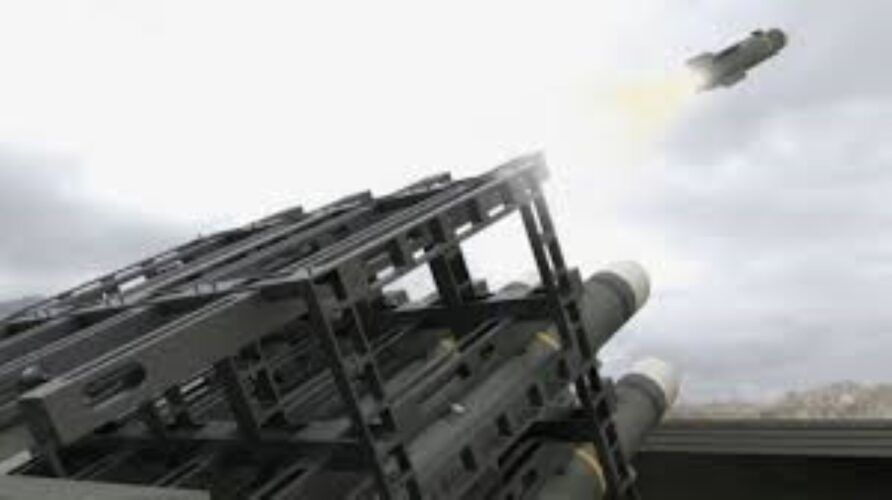
Then came the Polish Ottokar-Brzoza (named after Brigadier General Ottokar Brzoza-Brzezina) programme that was intended to provide the Polish Army with a modern tank destroyer. At the MPSO 2019 trade show, two vehicles were shown, a modified BWP-1 with 12 Brimstone missiles and an 8-round launcher on a modified K9P vehicle.
A second industry dialogue in 2020 widened the options, including a wheeled option for the base vehicle. Various missiles and vehicles were considered including options from MBDA, Lockheed Martin, Rheinmetall, AMZ Kutno and Polska Grupa Zbrojeniowa.
MBDA and PGZ won, with a contract signing in July 2022, read more at Defence24 (they have excellent coverage of this and other Polish defence matters). The missiles will be carried on the 4×4 AUTOSAN Tactical Multi-Purpose Vehicle
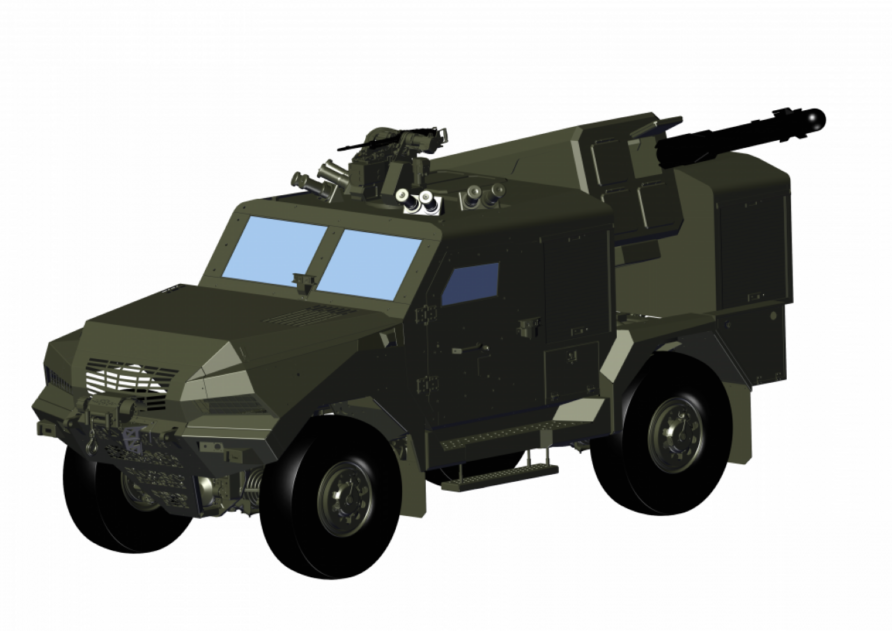
In May 2021, the Defence Science and Technology Laboratory (DSTL) released details of the Army’s requirements for Battle Group Organic Anti-Armour (BGOAA). Briefly, it comprised;
- Close-In Self Defence (CISD): portable lightweight munitions carried by Infantry sections
- Mounted Close Combat Overwatch (MCCO): a long-range system providing anti-armour coverage to the battle group, with concepts carrying multiple missiles weighing up to 50 kg with a range of up to 10 km or more
- Close Combat Anti-Armour Weapons (CCAAW): Mounted and Dismounted, capable of destroying armoured vehicles even if hidden from view
The 2019 Street fighter project was a user-led initiative to test out several different concepts for the Challenger Main Battle Tank.
Concept
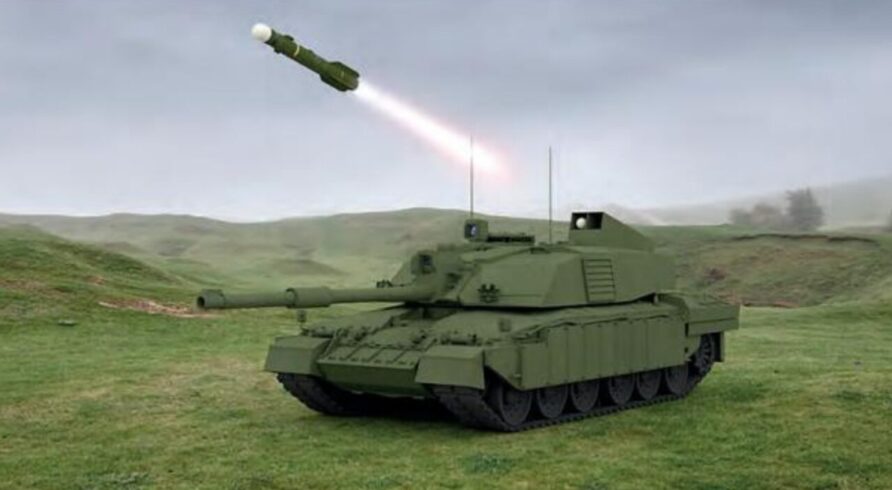
Mock-up
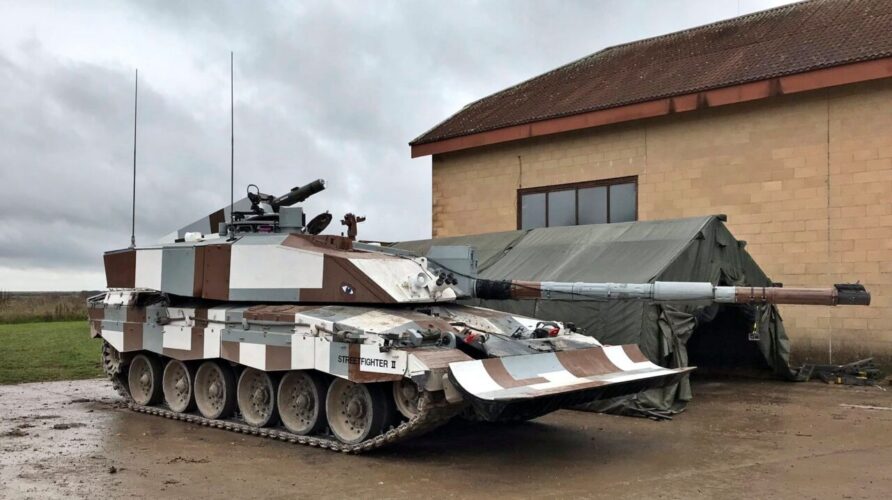
The MCCO requirement was characterised as ‘capable of engaging targets up to 10 km away with missiles weighing up to 50 kg’. DSTL was working within the Weapon Systems Research Framework and with prime contractors, Lockheed Martin, MBDA and Thales.
Commenting on MCCO, Pickering said: “If we took Swingfire nowadays, the Swingfire missile system would, noting the detectability of the host platform, would not provide anywhere near sufficient range. This is looking at providing an organic battle group anti-armour capability with a range in excess of 10 km. “The idea is MCCO would be in a position to provide dedicated anti-armour support to any user within the battle group… to allow a dismounted force to be able to call in an MCCO-class effector.”
Several initial concepts emerged, with both Brimstone and Hellfire/JAGM (Brimstone variants shown below)
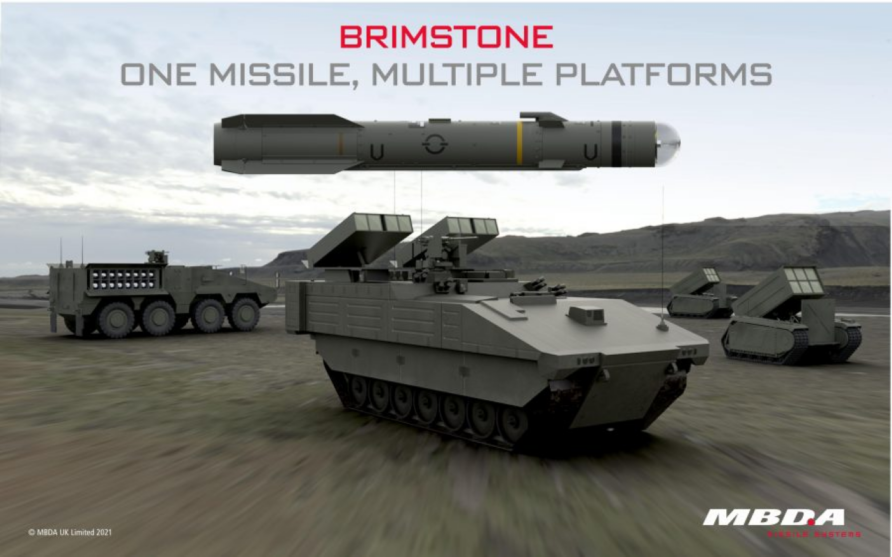
These initial concepts have been developed further by several manufacturers.
Boxer
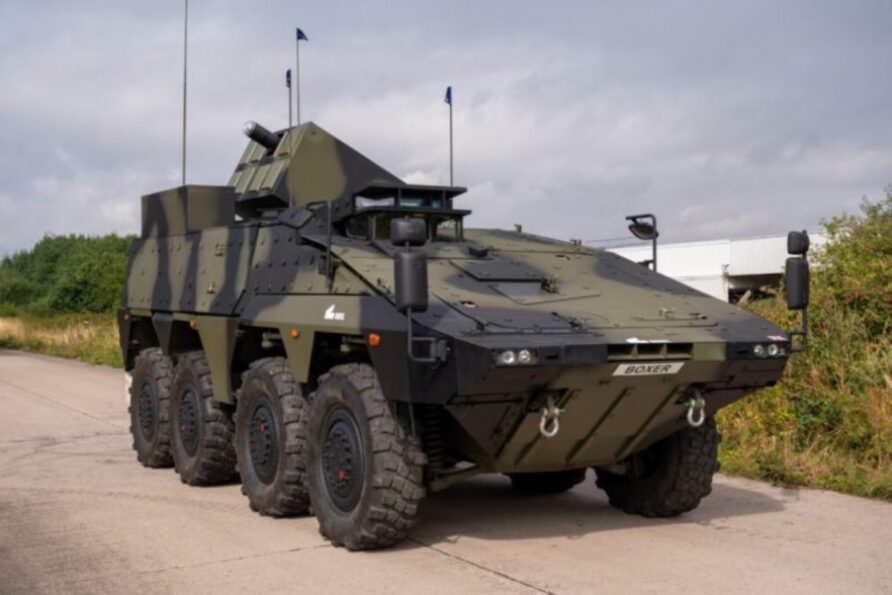
Supacat HMT
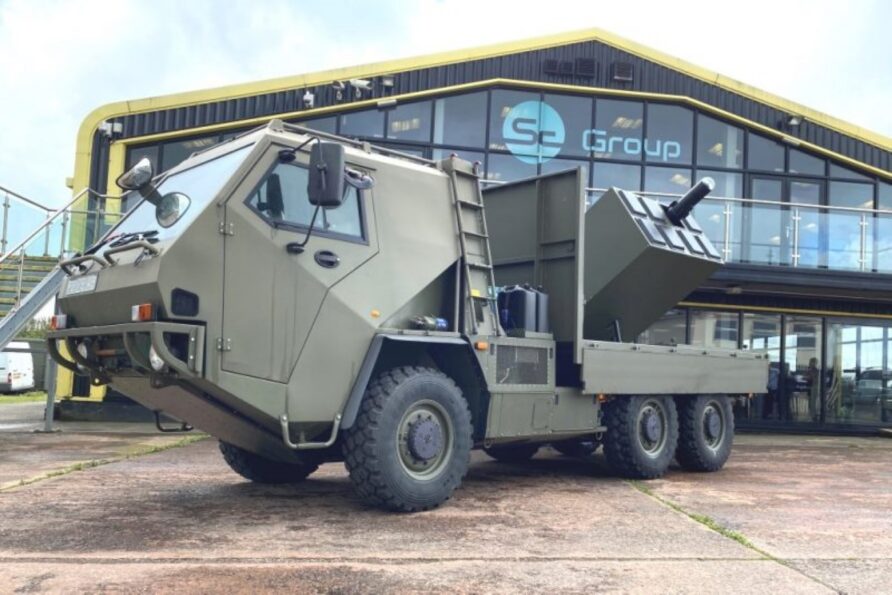
General Dynamics Ares
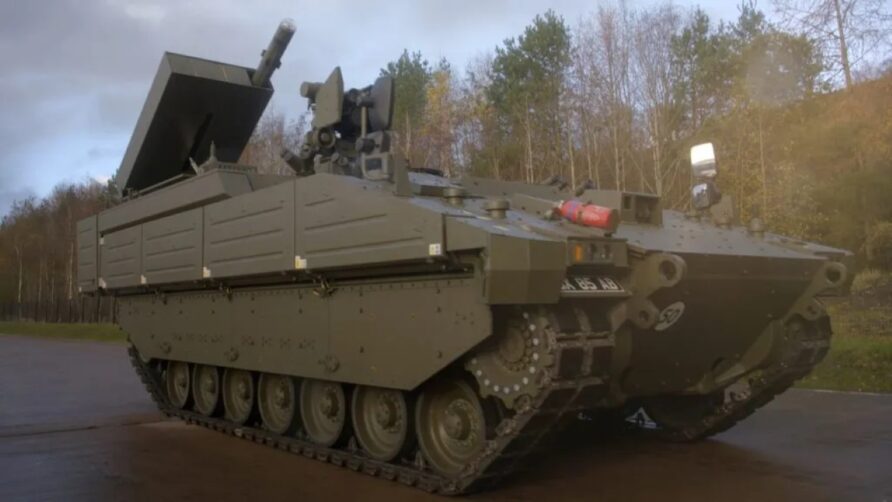
Rheinmetall Mission Master XT
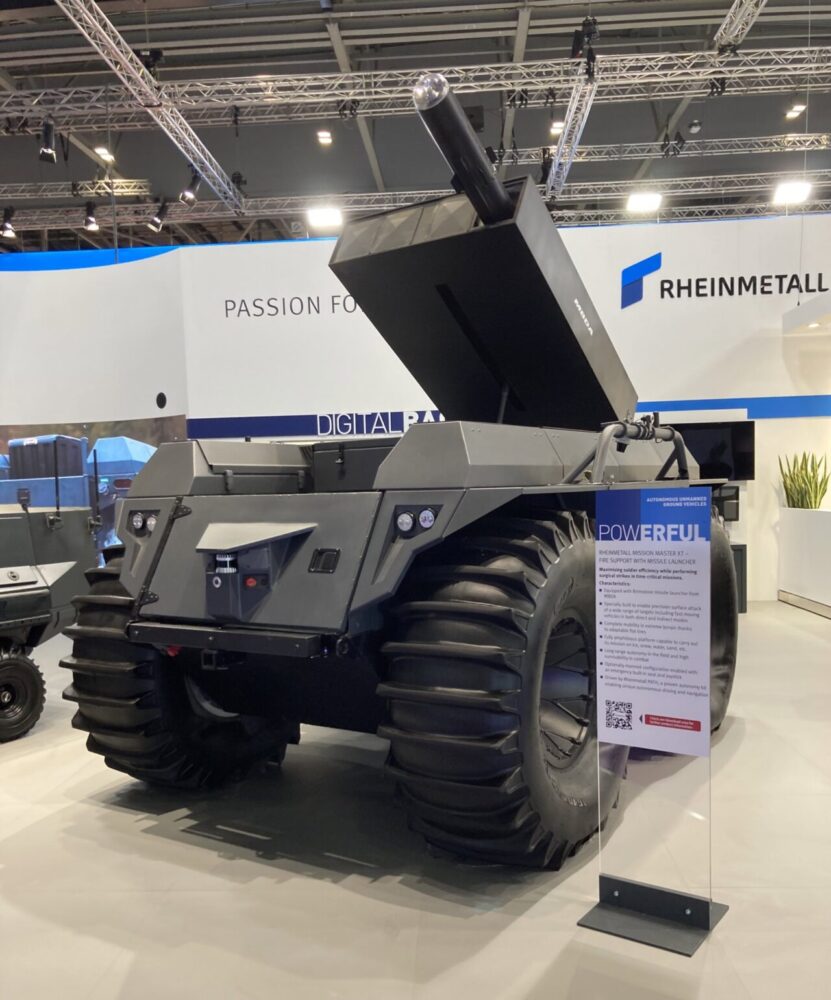
Melrem Themis
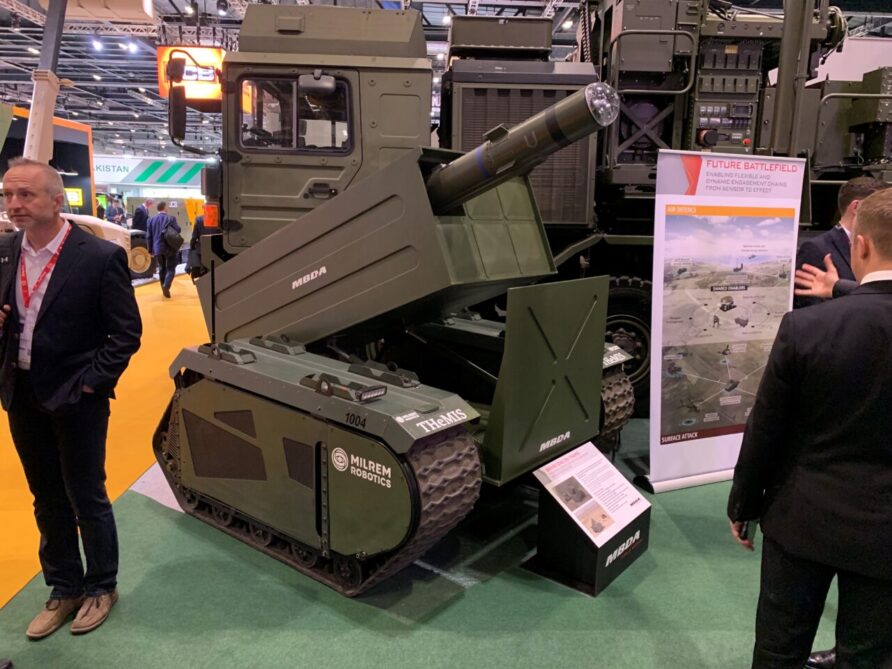
So, this but with…
BGOAA is not to be confused with Future Land Indirect Fires (and now Land Precision Strike), some early concepts of which seem to combine parts of Brimstone with other missiles and rockets.
Project Wolfram vehicle design and integration progressed, and in July 2023, shown on a representative Supacat HMT, and at Exercise WESSEX STORM.
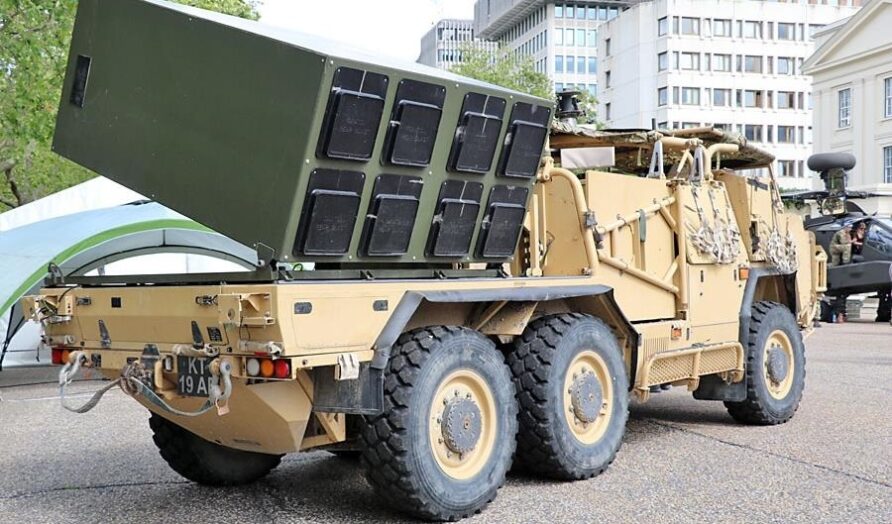
A Word or Two on Brimstone Range
MBDA and the MoD have always been (rightly) somewhat reserved in releasing the Brimstone range, and over the years, the ‘official’ figure has varied somewhat.
Brimstone 3Bs maximum operational range is increased by more than 20% over an already significantly improved range in Brimstone 2.
There is a great deal of speculation about the maximum range.
The original Brimstone was described as having a maximum range of 8 km, but the latest MBDA Brimstone data sheets don’t have a range at all.
Some publicly available materials on the Polish Brimstone tank destroyer mention 12 km.
The Mounted Close Combat Overwatch (MCCO) materials describe a range of exceeding 10 km.
Other sources describe varying ranges up to 60 km.
I expect these extreme ranges are only available with an optimal flight trajectory from a very high speed, very high altitude launch, if at all.
It makes sense to me that the range will depend on all sorts of factors, but I think it will be within the 8-12 km band.
Click HERE to read about other UK Complex Weapons
Change Status
| Change Date | Change Record |
| 30/04/2016 | Initial issue |
| 29/07/2021 | Update and format refresh |
| 15/10/2022 | Major refresh and update |
| 29/07/2023 | Minor updates |
| 25/10/2023 | Added DSCA notification of JAGM and Hydra 400 |
| 04/05/2024 | Germany Typhoon decision. |

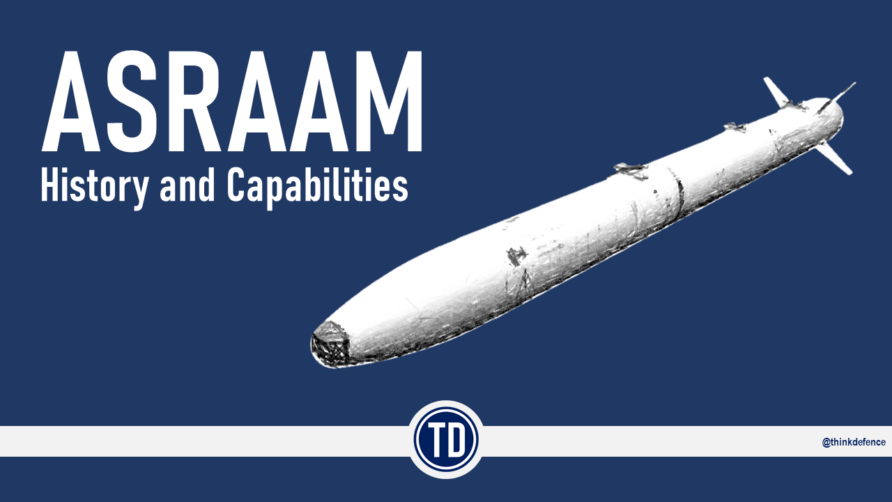
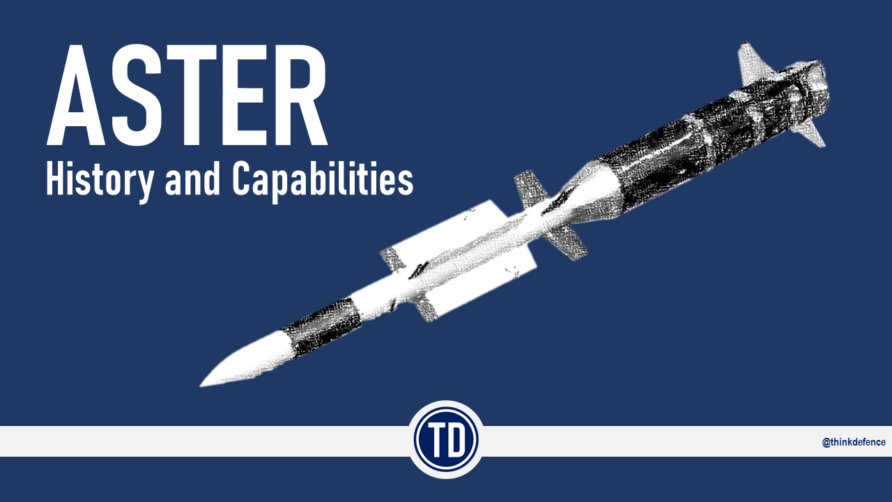
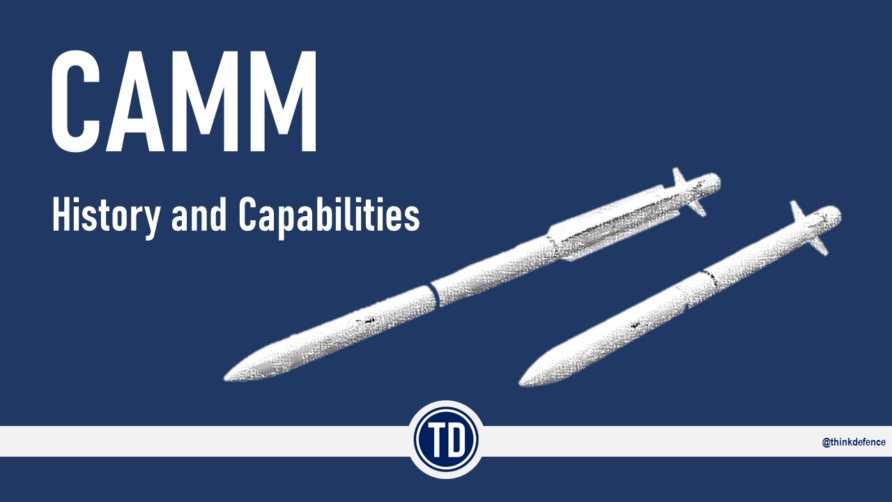
Very informative article, i especially enjoyed the historical section and the overview of the competitors to/for Brimstone. However i noticed a small error: After the description of the ML/Rheinmetall Damocles, there is a drawing of three descending submunitions. This drawing does not show the Rheinmetall ZEPL, but the unrelated Textron Damocles. The Textron submunition can be recognized by its use of a steerable parafoil instead of a parachute, to extend its search area. The same drawing (labelled correctly) can be found in 'Field Artillery (March-April 1997): Improving the Effects of Fires with Precision Munitions' available online (https://tradocfcoeccafcoepfwprod.blob.core.usgovcloudapi.net/fires-bulletin-archive/1997/MAR_APR_1997/MAR_APR_1997_FULL_EDITION.pdf)
Unfortunately i havent yet managed to find any pictures of ZEPL, only some of its EFP.
Thanks Voltzz, I will have a look and correct!